Customer Centricity – Workshop 1 (Championing Customer-Centricity)

The Appleton Greene Corporate Training Program (CTP) for Customer Centricity is provided by Ms. Dickson Certified Learning Provider (CLP). Program Specifications: Monthly cost USD$2,500.00; Monthly Workshops 6 hours; Monthly Support 4 hours; Program Duration 12 months; Program orders subject to ongoing availability.
If you would like to view the Client Information Hub (CIH) for this program, please Click Here
Learning Provider Profile

Ms. Dickson has experience in consultancy, healthcare, technology, FMCG and the public sector. She has worked with numerous research projects for over 20 years and is passionate about understanding customer behavior, turning insights into clear strategies.
She has a Master of Science in Business Administration, specializing in Marketing. In addition, she has completed a number of other training programs such as Cognitive Science, Project Management Professional Certification Program and Digital Marketing.
Her service skills include: business strategy and business development, concept and product development, sales and marketing, strengthening company image, brand and organization as well as process development and management. Her commercial experience includes the following countries: US, UK, Germany, Sweden and France or more specifically NY, London, Berlin, Stockholm and Paris.
Some examples of personal achievements are developing innovative products/services, meeting customer needs and driving market demand. Effective marketing campaigns, enhancing brand visibility and improving sales conversions. Developed and implemented process improvements, reducing costs, increasing efficiency and enhancing product/service quality.
MOST Analysis
Mission Statement
Everything we do should begin with knowing our customers, if we truly understand our customers’ motivations, drivers, and behaviors we are more likely to be successful with our products and solutions. Organizations that listen and understand their customers are more profitable than those that don’t and are more efficient. The workshop focuses on developing actionable strategies for customer-centric transformation. Participants will learn how to align their entire organization around customer-centricity, fostering a culture prioritizing customer needs and expectations.
Objectives
01. Introducing Customer-centricity. Time Allocated: 1 Month
02. Collaborative Learning. Time Allocated: 1 Month
03. Customer Feedback. Time Allocated: 1 Month
04. Customer Segmentation. Time Allocated: 1 Month
05. Persona Development. Time Allocated: 1 Month
06. Customer Journey Mapping. Time Allocated: 1 Month
07. Customer Experience (CX). Time Allocated: 1 Month
08. Customer-Centric Innovation. Time Allocated: 1 Month
09. External Stakeholders. Time Allocated: 1 Month
10. Internal Stakeholders. Time Allocated: 1 Month
11. Roadmap Development. Time Allocated: 1 Month
12. Organization Change. Time Allocated: 1 Month
Strategies
01. Introducing Customer-centricity and benefits linked to this approach.
02. Using Collaborative Learning as a tool to become a true customer-centric organization.
03. Explore how Customer Feedback is an important customer-centric element.
04. How to do a sufficient Customer Segmentation.
05. Persona Development, bringing customer segments to live.
06. Customer Journey Mapping, how customers interact with your solutions.
07. Customer Experience (CX) a deep dive into customers’ emotions, and perceptions.
08. Customer-centric Innovation, engaging customers through co-creation.
09. External Stakeholders, who they are, and how to engage.
10. Internal Stakeholders, getting everyone on board on the customer-centric journey.
11. Roadmap Development, an important tool in becoming more customer-centric.
12. Organization Change, how to effectively manage necessary changes in the organization towards becoming more customer-centric.
Tasks
01. Set aside some time to reflect on what it involves for your organization to become more customer-centric, make notes
02. Set up at least one meeting within the coming 30 days including all participants in the workshop to discuss how to work together in becoming a customer-centric organization.
03. Initiate a discussion with relevant stakeholders around customer segmentation and how to best conduct (or review/improve) in your organization. Set a time plan for the activity.
04. Initiate a discussion with relevant stakeholders around persona development and how to best conduct (or review/improve) in your organization. Set a time plan for the activity.
05. Initiate a discussion with relevant stakeholders around the customer journey and how to best conduct (or review/improve) in your organization. Set a time plan for the activity.
06. Initiate a discussion with relevant stakeholders around the customer experience and how to best conduct (or review/improve) in your organization. Set a time plan for the activity.
07. Set up a feedback session with one of your clients (either individually or with 2-3 other workshop participants). Understand your customer’s experience with your product/service and document any areas of improvement.
08. Examine a product enhancement or new feature introduction in your industry. Understand its motivation and assess its impact on the customer experience.
09. Identify three major external stakeholders for your company (e.g., suppliers, industry regulators, trade associations). Assess their influence on your company’s decision-making process.
10. List departments or teams within your organization that influence customer relations. Reflect on how collaboration between these stakeholders can be enhanced.
11. Initiate a discussion with relevant stakeholders around roadmap development and how to best conduct (or review/improve) in your organization. Set a time plan for the activity.
12. Watch a documentary, read a book, or an article about a company’s transformative journey. Identify the drivers for change, the strategies implemented, and the outcomes achieved. Make notes.
Introduction
Welcome to our first workshop on customer-centricity! In a rapidly evolving business landscape, customer-centricity has emerged as a cornerstone of sustainable success. This workshop is designed to equip you with the essential knowledge and skills to not only understand the significance of customer-centricity but also to implement it effectively within your organization. Over the course of this workshop, we will delve into a comprehensive range of topics, enabling you to foster a customer-first approach that drives innovation, growth, and long-term profitability.

Barriers to Customer-Centric Transformation
Several reasons contribute to why some companies remain product-centric rather than embracing a customer-centric approach. While the shift towards customer-centricity has gained momentum, certain challenges and organizational factors can impede this transformation such as:
• Traditional Mindset: Many organizations have a long history of focusing on product development and innovation. This entrenched mindset can be resistant to change, especially when it comes to reorienting the entire company around customer needs.
• Short-Term Perspective: Companies often prioritize short-term goals, such as meeting quarterly revenue targets. This can lead to a focus on pushing products to market quickly, overshadowing the longer-term benefits of building strong customer relationships.
• Internal Silos: Organizational silos can hinder the flow of information across departments, making it difficult to gather and share customer insights. This lack of collaboration can result in disjointed efforts and hinder a customer-centric approach.
• Lack of Customer Insight: Some companies lack a robust mechanism for gathering and analyzing customer feedback and data. Without a deep understanding of customer needs and preferences, it’s challenging to implement effective customer-centric strategies.
• Overemphasis on Competition: Companies that are highly competitive might prioritize outdoing competitors in terms of features and functionalities rather than truly understanding and meeting customer needs.
• Risk Aversion: Moving towards customer-centricity often involves experimenting with new approaches and adapting to changes. Some companies may be risk-averse and hesitant to depart from tried-and-true methods.
• Lack of interest and comfort: Familiarity with the product-centric approach can breed a sense of comfort, making it difficult to embrace a new way of doing things. Change requires effort, resources, and a willingness to challenge the status quo.
• Lack of Leadership Buy-In: For a shift towards customer-centricity to succeed, it requires strong leadership support and a clear vision. If leadership doesn’t champion this change, it’s challenging to cascade the mindset shift throughout the organization.
• Resource Allocation: Organizations often allocate resources based on existing priorities. Shifting towards customer-centric strategies might necessitate reallocating resources, which can face resistance from those accustomed to the status quo.
• Misaligned Metrics: Metrics like sales numbers or product features might be more tangible and easier to measure than customer satisfaction or loyalty. This can lead to a focus on the measurable but less customer-oriented aspects of the business.
• Lack of Training and Skillset: Employees might lack the necessary skills and training to understand and implement customer-centric practices effectively.
• Complexity: Adapting to a customer-centric approach can be complex, requiring changes in processes, communication, and even the company culture. This complexity can deter companies from making the transition.
• Perceived Customer Homogeneity: Companies might mistakenly assume that their customer base is homogeneous, leading them to believe that a single product-centric approach will suit all customers.
• Market Pressure: In highly competitive industries, the pressure to launch new products quickly can take precedence over comprehensive customer research, leading to product-centric decision-making.
Despite these challenges, more companies are recognizing the benefits of embracing customer-centricity. It’s essential to overcome these hurdles and prioritize customer needs to remain relevant, competitive, and sustainable in a rapidly evolving business landscape.

Product-centricity drawbacks
Adopting or staying with a product-focused approach can lead to significant disadvantages that hinder an organization’s growth, sustainability, and competitive edge. While product innovation remains crucial, neglecting the customer-centric perspective can have far-reaching effects that undermine long-term success such as:
• Limited Market Understanding
• Missed Opportunities for Innovation
• Reduced Customer Loyalty
• Inefficient Resource Allocation
• Shortened Product Lifecycles
• Lack of Differentiation
• Inadequate Problem Solving
• Poor Customer Experience
• Vulnerability to Disruption
• Missed Upselling and Cross-Selling Opportunities
• Lack of customer retention
Let’s have a closer look at each of these potential disadvantages.
• Limited Market Understanding: A product-focused company may prioritize the development of features and functionalities that align with internal perceptions rather than actual customer needs. This approach can result in offerings that miss the mark in terms of relevance and fail to address evolving customer preferences.
• Missed Opportunities for Innovation: Relying solely on product-centric innovation can limit the potential for breakthroughs. A customer-centric approach encourages innovation based on deep insights into customer pain points, desires, and behavioral patterns, driving more meaningful and impactful product developments.
• Reduced Customer Loyalty: Without a customer-centric focus, businesses risk failing to build strong relationships with their customer base. This can lead to lower customer loyalty and advocacy, as customers may feel disconnected from products that don’t align with their expectations and needs.
• Inefficient Resource Allocation: A product-centric approach might lead to resource allocation that prioritizes product development at the expense of other critical aspects, such as customer service, experience enhancement, and post-purchase support.
• Shortened Product Lifecycles: Relying solely on product-driven strategies can result in a shorter lifespan for offerings. Products that are not continually refined based on customer feedback and changing needs can become obsolete more quickly.
• Lack of Differentiation: In a market saturated with choices, a product-focused company might struggle to differentiate itself from competitors. Customer-centric businesses can stand out by providing tailored experiences and solutions that resonate with individual customers.
• Inadequate Problem Solving: A product-focused mindset might not effectively address complex customer challenges. By understanding customer pain points through a customer-centric lens, companies can develop solutions that provide genuine value and solve real-world problems.
• Poor Customer Experience: Without considering the entire customer journey, from pre-purchase research to post-purchase support, a product-focused approach may lead to disjointed experiences that leave customers frustrated and dissatisfied.
• Vulnerability to Disruption: Markets and customer preferences change rapidly. Companies that are solely product-focused might struggle to adapt to shifts in customer demand or technological advancements, making them more vulnerable to industry disruption.
• Missed Upselling and Cross-Selling Opportunities: A customer-centric approach enables businesses to identify opportunities for upselling and cross-selling based on a deep understanding of each customer’s needs and preferences. A product-focused approach often lacks this level of personalization.
• Lack of customer retention: A product-centric approach might prioritize acquiring new customers over retaining existing ones, potentially leading to a high churn rate where customers disengage from the organization after just one purchase or interaction.
While product innovation is undoubtedly essential, companies that fail to embrace customer-centricity risk falling behind in an era where customer preferences, experiences, and expectations increasingly drive business success. By shifting towards a customer-centric approach, organizations can build stronger customer relationships, drive innovation, and achieve sustained growth in an ever-evolving market.
Unlocking Success with Customer-Centric Strategy
A customer-centric approach recognizes that customers are the essence of a business and aims to create value for them at every touchpoint.
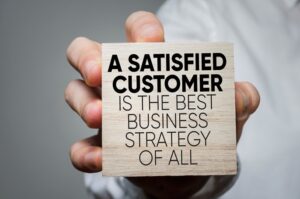
Having a customer-centric approach and strategy is vital for several reasons:
Enhanced Customer Satisfaction: By understanding and catering to customer needs, companies can deliver products, services, and experiences that align with customer expectations. This leads to higher levels of customer satisfaction and loyalty. Satisfied customers are more likely to become repeat buyers, refer others to the company, and provide valuable feedback for improvement.
Competitive Advantage: In a crowded marketplace, customer centricity can serve as a key differentiator. Companies that genuinely focus on customers and consistently exceed their expectations stand out from their competitors. This differentiation can help attract new customers, retain existing ones, and foster long-term relationships, ultimately leading to a sustainable competitive advantage
Improved Customer Retention and Lifetime Value: A customer-centric approach fosters customer loyalty and mitigates customer turnover. By consistently providing exceptional experiences, companies can build strong relationships with their customers, leading to repeat purchases and increased customer lifetime value. Retaining existing customers is often more cost-effective than acquiring new ones, making customer centricity a valuable strategy for maximizing profitability
Increased Revenue and Profitability: When companies align their strategies with customer needs and preferences, they are more likely to develop and offer products and services that customers value. This can lead to increased sales, higher average transaction values, and improved overall profitability. According to research carried out by Deloitte, customer-centric companies are 60% more profitable than those not focused on the customer. Additionally, customer-centric companies benefit from positive word-of-mouth referrals and a strong reputation, attracting new customers and expanding their market share.
Better Decision Making: A customer-centric approach provides valuable insights into customer behavior, preferences, and market trends. By actively listening to customers and gathering data, companies gain a deeper understanding of their target audience. This knowledge enables informed decision-making across various areas, such as product development, marketing campaigns, and customer service initiatives. Customer-centric companies base their decisions on data-driven insights, reducing the risk of costly mistakes and increasing the likelihood of success.
Innovation and Adaptability: A customer-centric approach encourages companies to continuously seek feedback, collaborate, and co-create with customers. This fosters innovation by uncovering new opportunities, identifying evolving customer needs, and developing solutions that address those needs. Customer-centric organizations are agile and adaptive, responding quickly to changing market dynamics and staying ahead of the competition.
Employee Engagement and Satisfaction: A customer-centric approach recognizes the vital role of employees in delivering exceptional customer experiences. When employees understand the company’s commitment to customers and see their efforts directly impacting customer satisfaction, it boosts their engagement and job satisfaction. Engaged employees are more motivated, productive, and committed to providing exceptional service, further reinforcing the customer-centric culture.
The Ongoing Path to Customer-Centric Success
 Embracing customer-centricity is not a one-time event; it is a continuous process that demands ongoing effort and investment. It requires companies to consistently listen to their customers, analyze their feedback, and adapt their strategies accordingly to remain customer-centric. Becoming customer-centric necessitates a cultural shift within an organization. It requires a strong commitment from leadership to prioritize the customer experience. Additionally, it calls for a willingness to invest in the necessary technology, processes, and training that support a customer-centric approach.
Embracing customer-centricity is not a one-time event; it is a continuous process that demands ongoing effort and investment. It requires companies to consistently listen to their customers, analyze their feedback, and adapt their strategies accordingly to remain customer-centric. Becoming customer-centric necessitates a cultural shift within an organization. It requires a strong commitment from leadership to prioritize the customer experience. Additionally, it calls for a willingness to invest in the necessary technology, processes, and training that support a customer-centric approach.
While customer-centricity is often associated with business-to-consumer (B2C) companies, its importance extends equally to business-to-business (B2B) companies. In fact, B2B companies may face even greater challenges in becoming customer-centric due to the complexity of their products and services, longer sales cycles, and multiple decision-makers involved.
Technology plays a significant role in enabling customer-centricity, but it is not the sole factor. Companies must also invest in their people, processes, and culture to truly embrace customer-centricity. It is the combination of these elements that creates a customer-centric organization.
Whereas customer service is an essential component of customer-centricity, it is not the only aspect. True customer-centricity requires a holistic approach that encompasses all facets of the customer experience, spanning from marketing and sales to product development and support.
Overall, customer-centricity is a complex and multifaceted concept that requires ongoing effort and investment. Companies that prioritize the customer experience and make a commitment to becoming customer-centric are more likely to succeed in today’s competitive business environment. Many companies have recognized the importance of transitioning from a product-centric approach to a customer-centric one to stay competitive in today’s business environment. Let’s explore a few examples of companies that have successfully made this shift:
Case Study
Initially, Netflix was a DVD rental company, that relied on a subscription model to provide customers with access to a vast library of movies and TV shows. However, as technology advanced, Netflix recognized the shifting preferences of customers toward streaming content. The company swiftly transitioned from a product-centric DVD rental service to a customer-centric streaming platform. By leveraging data analytics, Netflix offers personalized recommendations, customizing content suggestions based on individual viewing habits. Its investment in original content production also demonstrates a customer-centric approach, creating shows and movies tailored to the diverse tastes of its global subscriber base.
Nike has undergone a significant transformation from a product-centric athletic footwear and apparel company to a customer-centric brand that focuses on the overall athletic experience. Nike’s customer-centric approach is evident in its deep understanding of athletes’ needs and aspirations. The company engages with its customers through social media, digital communities, and events, fostering a sense of belonging and motivation. Nike’s innovation initiatives, such as its Nike+ platform and personalized product customization options, enable customers to have a more immersive and tailored experience, strengthening the customer-brand relationship.
These examples highlight how companies across different industries have successfully transitioned from a product-centric approach to a customer-centric one. By understanding customer needs, leveraging data and technology, personalizing experiences, and fostering strong customer relationships, these companies have been able to differentiate themselves, attract loyal customers, and drive business growth in an increasingly customer-driven marketplace.
In summary, a customer-centric approach and strategy are essential for companies seeking sustainable growth and success. By prioritizing the needs, preferences, and overall experience of customers, organizations can enhance customer satisfaction, gain a competitive advantage, increase customer retention and lifetime value, drive revenue and profitability, make better-informed decisions, foster innovation, and create a positive work environment. Embracing customer centricity is not just a strategy; it becomes a fundamental aspect of the company’s culture and mindset, paving the way for long-term success in today’s customer-driven business landscape.
The Evolution of Customer-Centricity: Shaping Future Business Landscape
As technology progresses and consumer demands evolve, the realm of customer-centricity is poised for exciting transformations. A closer examination reveals the potential evolution of customer-centric strategies that will redefine the business landscape in the years to come. Let’s have a look at some likely developments.
Leveraging Data Analytics
Advancements in data analytics, artificial intelligence (AI), and machine learning open the door to hyper-personalization. Companies stand to gain unprecedented access to extensive customer data, enabling profound insights into individual preferences, behaviors, and needs. Armed with these insights, businesses can deliver tailored experiences, products, and services. Imagine an e-commerce platform utilizing real-time data to provide personalized product recommendations based on browsing history, purchase patterns, and contextual cues. Moreover, tailored communication strategies will ensure that customers receive relevant content and offers via their preferred channels. This heightened personalization not only boosts customer satisfaction but also cultivates loyalty and drives advocacy.
Integrating Online and Offline Channels
In the future, customers will demand seamless integration across online and offline channels. They will engage with businesses through diverse touchpoints, ranging from websites and mobile apps to physical stores and emerging technologies like augmented reality (AR) and virtual reality (VR). To meet these expectations, companies must invest in technologies that facilitate a unified customer journey across channels.
Enabling Omnichannel Consistency
To provide a truly seamless omnichannel experience, consistent branding, messaging, and user experience across all touchpoints are essential. Companies will harness tools such as customer relationship management (CRM) systems, integrated data platforms, and advanced analytics to gain a comprehensive understanding of customer interactions and preferences.
AI-Powered Efficiency
As voice assistants and smart devices proliferate, voice-enabled interactions will dominate. Customers will increasingly engage with companies using voice commands, relying on technologies like chatbots, virtual assistants, and smart speakers. These interactions, powered by AI, will facilitate personalized responses, address inquiries, and offer relevant recommendations.
Voice interactions will not only comprehend and respond to customer queries but also learn from each interaction, refining responses over time. Through AI-driven voice interactions, companies can deliver efficient and convenient customer service, thereby enhancing the overall experience and fostering satisfaction.
Customer-centric organizations will strive to anticipate customer needs and provide proactive solutions. By leveraging advanced analytics and predictive modeling, companies can identify patterns in customer behavior and offer recommendations before customers express their needs.
Predictive data and AI algorithms will empower businesses to reach out to customers proactively with offers, promotions, or personalized content aligned with their interests. This proactive approach showcases a deep understanding of customers and enhances satisfaction by saving time and effort in finding desired solutions.
Co-Creation: Engaging Customers as Collaborators
Companies are shifting their perspective on customers, involving them as active contributors and collaborators in the innovation process. Engaging customers in ideation sessions, surveys, and online communities provides insights for new product features or improvements.
Co-creation fosters a sense of ownership and strengthens the bond between customers and the brand. This strategy ensures that offerings genuinely align with customer needs and preferences, resulting in heightened satisfaction and loyalty.
Responsible Customer-Centricity
As customers become more socially and ethically conscious, businesses must align customer-centric strategies with responsible practices, addressing privacy, data security, diversity, inclusion, environmental impact, and social responsibility.
Companies should handle personal data with care, respect privacy preferences, and offer transparent information about data usage. Embracing diversity, sustainability, and social responsibility builds trust and loyalty among conscientious customers.
Enhanced Experiences
Emerging technologies like AR, VR, and MR will play a pivotal role in enhancing customer experiences, bridging the gap between physical and digital interactions. Customers will use AR applications to visualize products in their surroundings or experience VR simulations for trying out different scenarios. These technologies provide innovative and engaging ways for customers to interact with products and services.
Embracing a Future of Exceptional Customer-Centricity
In conclusion, the future of customer-centricity holds immense potential for businesses to craft extraordinary experiences and establish meaningful connections with customers. The combination of hyper-personalization, seamless omnichannel experiences, voice and AI-powered interactions, proactive service, co-creation, ethical considerations, and integration of emerging technologies will equip companies to exceed customer expectations, deliver remarkable experiences, fostering strong relationships, and maintain competitiveness amidst a dynamically changing business landscape.
Executive Summary
In today’s competitive business environment, understanding and addressing the needs of customers is crucial for success. In this workshop, we will explore the numerous benefits that come with implementing a customer-centric strategy.
We will discuss how businesses can enhance customer satisfaction, increase loyalty, and improve the overall customer experience by understanding and addressing customer needs. We will also explore how prioritizing customer needs and building strong relationships can reduce churn and increase retention rates.
In addition, we will examine how customer-centricity can provide a competitive advantage, helping businesses stand out and attract more customers in today’s competitive market.
Throughout the workshop, we will engage in interactive activities and discussions to help you understand how to implement a customer-centric strategy in your own business. By the end of the session, you will have a deeper understanding of the benefits of customer-centricity and how it can drive long-term success.
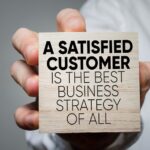
Chapter 1: Introducing Customer-Centricity
In this session, we will explore the importance of adopting a customer-centric strategy in today’s competitive business environment.
We will begin by discussing what it means to be customer-centric and how this approach involves shifting the focus of a business toward prioritizing the needs and preferences of customers. This includes analyzing customer needs and pain points, building better relationships with customers, and increasing customer retention. We will also discuss how this approach recognizes that satisfied customers are crucial for long-term success and profitability.
Next, we will explore the benefits of customer-centricity, including improved customer satisfaction, increased customer loyalty, enhanced customer experience, higher customer retention, and competitive advantage.
We will also compare and contrast customer-centricity with product-centricity, two different approaches to business strategy. While product-centricity emphasizes the product itself, customer-centricity places the customer at the core of decision-making and aims to create value by meeting their needs and expectations.
Throughout the workshop, we will engage in interactive activities and discussions to help you understand how to implement a customer-centric strategy in your own business. By the end of the session, you will have a deeper understanding of the importance of customer-centricity and how it can drive long-term success.

Chapter 2: Collaborative Learning
Collaborative learning is an approach to education that emphasizes the importance of social interaction and cooperation among learners. By engaging in interactive exercises and group discussions, participants are encouraged to work together, share their knowledge and experiences, and learn from one another. This approach recognizes that learning is not a solitary activity, but rather a social process that involves the exchange of ideas and the construction of knowledge through collaboration. By working together, learners can develop a deeper understanding of the subject matter, as well as important skills such as critical thinking, problem-solving, and communication.
In this session, our goal is to create a collaborative learning environment where participants can learn from one another, share their experiences, and build on each other’s knowledge. To achieve this, we will begin by providing opportunities for participants to get to know each other. Through interactive exercises and group discussions, participants will have the chance to share their experiences, insights, and challenges. This will help to build a sense of community among participants and lay the foundation for effective collaboration and knowledge sharing.
Collaborative learning is a powerful approach to education that recognizes the value of diverse perspectives and the importance of social interaction in the learning process. By working together, learners can develop a deeper understanding of the subject matter, as well as important skills such as critical thinking, problem-solving, and communication.
Throughout the session, we will encourage participants to actively engage with one another, share their ideas, and work together towards a common goal. By creating a supportive and inclusive learning environment, we aim to foster a sense of collaboration and promote knowledge sharing among participants.
In addition to interactive exercises and group discussions, we will also provide participants with tools and resources to support their collaborative learning journey. By the end of the session, participants will have developed stronger connections with the other participants. By fostering collaboration and knowledge sharing among participants, we can create a dynamic and engaging learning environment that supports the growth and development of all learners.
Chapter 3: Customer Feedback
Discover the transformative potential of actively listening to customer feedback and learn how it can fuel the growth of your business. In this session, we will dig into the importance of customer feedback, explore its benefits, and uncover effective strategies to gather and utilize this valuable information. By incorporating these techniques, you will be equipped to drive innovation, enhance customer satisfaction, and achieve long-term success.
Customer feedback serves as a window into the desires, needs, and expectations of your target audience. By actively listening to their feedback, you gain deeper insights into their pain points, preferences, and expectations, empowering you to align your products and services accordingly. Understanding your customers is the first step towards delivering exceptional experiences.
Customer feedback acts as a guiding compass, pointing out areas where your products or services may be falling short. By paying attention to their input, you can identify and address any shortcomings, allowing you to make necessary improvements and elevate the overall customer experience. Embracing feedback as an opportunity for growth is key to staying competitive.
Actively listening to customer feedback demonstrates a genuine commitment to your customers’ opinions and needs. By promptly addressing their concerns and incorporating their feedback into your business practices, you create a strong bond of trust and increase customer satisfaction. Satisfied customers become loyal advocates who positively impact your brand’s reputation.
Furthermore, customer feedback has the power to inspire innovation and drive your business forward. By actively listening to customer suggestions, ideas, and pain points, you can gather fresh perspectives and discover opportunities for product development and service enhancements. Embracing customer feedback as a catalyst for innovation allows you to stay ahead of the curve and surpass customer expectations.
When you actively listen to customer feedback and take action based on their input, you foster a sense of appreciation and respect. Customers value being heard and understood, leading to increased loyalty and long-term relationships. Building a loyal customer base is a strategic advantage that amplifies your brand’s reputation and generates positive word-of-mouth.
Engaging with your customers and gathering their feedback can be achieved through various means such as:
• Surveys and feedback forms: Conduct targeted online or email surveys to gather specific insights about your products or services. Leverage user-friendly survey tools to streamline the process.
• Social Media Listening: Monitor social media platforms to track brand mentions and engage with customers who leave feedback or reviews, gaining valuable insights into their sentiments and preferences.
• Customer Reviews and Ratings: Encourage customers to leave reviews and ratings on platforms such as Google, Yelp, or industry-specific review sites. Actively respond to reviews to show appreciation for their feedback.
• User Testing: Conduct user testing sessions to observe how customers interact with your products or features. Actively listen to their feedback and suggestions to refine and optimize your offerings.
• Customer Advisory Boards or Focus Groups: Invite a select group of customers to participate in advisory boards or focus groups, fostering meaningful discussions and gaining insights into their preferences and needs.
By actively listening to customer feedback, you unlock a world of opportunities for growth and success. Understanding customer needs, identifying areas for improvement, enhancing satisfaction, driving innovation, and building loyalty are the outcomes of embracing feedback. With effective strategies to gather feedback, you empower your business to make data-driven decisions that push you ahead of the competition and ensure long-term prosperity.

Chapter 4: Customer Segmentation
Customer segmentation is a powerful tool that empowers businesses to understand and accommodate to their customers’ unique needs which we will cover in this part of the workshop. By grouping customers based on shared characteristics like demographics, behavior, or preferences, businesses can create tailored products, services, and marketing strategies that make the most efficient use of resources.
A major advantage of customer segmentation is its ability to deepen customer understanding. By analyzing customer data and uncovering patterns and trends, businesses gain valuable insights into what influences customer behavior and decision-making. Armed with this knowledge, they can develop targeted marketing campaigns, enhance their product offerings, and elevate the overall customer experience.
Moreover, customer segmentation helps businesses stand out from their competitors. By customizing their products and services to address the specific requirements of different customer segments, businesses can establish a distinctive value proposition that sets them apart in the market. This approach attracts new customers, fosters loyalty among existing ones, and ultimately drives long-term growth and profitability.
Another notable benefit of customer segmentation is its role in optimizing resource allocation. By concentrating efforts on the most profitable customer segments, businesses can maximize their return on investment and ensure optimal utilization of resources.
To sum up, customer segmentation is a vital tool for businesses seeking to gain deeper insights into their customers and tailor their offerings accordingly. By dividing their customer base into distinct groups, businesses can gain valuable insights, differentiate themselves from competitors, and optimize resource allocation, leading to enhanced success and growth.

Chapter 5: Persona Development
Persona development is a critical step that follows customer segmentation in the process of creating a comprehensive and effective marketing strategy. While customer segmentation involves dividing a broader target market into distinct groups based on common characteristics, persona development takes this a step further by creating detailed and relatable profiles that represent the key segments identified through segmentation.
Personas are fictional, yet highly realistic, representations of your target customers. They are created to embody the behaviors, motivations, goals, preferences, and challenges of specific customer segments. Personas go beyond demographic information taking psychological and behavioral insights into consideration and help marketers and other stakeholders to better understand and relate to their audience.
Persona development is a structured process that involves collecting data about your customer segments, identifying key characteristics, and creating detailed profiles with names, behaviors, goals, needs, and pain points. This information helps you map the customer journey, understand communication preferences, and even add a visual representation for relatability. Persona development provides insights that lead to precise messaging, product refinement, and enhanced customer experiences.
The benefits of persona development are multi-layered. Firstly, it enables precise messaging by understanding each segment’s motivations and pain points, facilitating targeted and resonant communication. Secondly, it serves as a guiding compass for product development, ensuring that offerings resonate with customers’ needs and preferences. Moreover, persona development elevates the customer experience through tailored interactions, leading to increased satisfaction and engagement. Resource allocation becomes efficient as persona-based strategies direct resources towards segments with optimal returns. Lastly, personas cultivate empathy by transforming abstract customer segments into relatable individuals, fostering a deeper understanding within teams.
Persona development is an essential step that builds upon customer segmentation, transforming data into relatable characters that drive informed decision-making. By understanding the motivations, behaviors, and preferences of each persona, businesses can create more personalized and effective marketing strategies that resonate with their target audience.

Chapter 6: Customer Journey Mapping
This session offers an exploration of customer journey mapping which will help participants to grasp the significance of understanding customer experiences holistically. Customer journey mapping is a strategic tool that encourages businesses to adopt a customer-centric approach. The customer journey mapping process involves creating a visual representation of the entire path a customer takes while interacting with a business and it empowers businesses to elevate their customer experiences.
The journey typically begins with the first point of contact and extends through various stages until the final interaction or conversion. It is a comprehensive approach that aims to capture every touchpoint, experience, and emotion a customer goes through during their interaction with the business.
Understanding the Customer Journey: The process of customer journey mapping goes beyond simply plotting out touchpoints. It involves exploring the customer’s perspective, emotions, and actions at each stage of their interaction with the business. This deeper understanding helps in identifying pain points, positive experiences, and areas of improvement within the journey.
Identifying Pain Points and Areas of Improvement: By visualizing the customer journey, businesses can pinpoint pain points and areas where customers might face difficulties, frustrations, or dissatisfaction. This could include issues like long wait times, confusing processes, or inconsistent service quality. Recognizing these pain points is essential as it provides a roadmap for addressing these issues and enhancing the overall customer experience.
Enhancing Customer Experience: Customer journey mapping provides valuable insights into how customers perceive and navigate through various touchpoints. This information can be used to enhance the customer experience at each stage. Businesses can identify opportunities to streamline processes, provide more relevant information, and create smoother transitions between different interactions. Ultimately, this leads to a more satisfying and memorable experience for customers.
Tailoring Products, Services, and Interactions: One of the key benefits of customer journey mapping is that it enables businesses to tailor their offerings to better meet customer needs. By understanding customer preferences, pain points, and expectations, businesses can adjust their products, services, and interactions to align with what customers truly value. This customization fosters stronger connections and loyalty among customers.
Gaps in the Customer Experience: Mapping the customer journey can reveal gaps or inconsistencies in the overall experience. These gaps might occur when customers transition between different touchpoints, departments, or channels. Identifying these gaps is crucial as it highlights areas where the customer experience might be disjointed or frustrating. Addressing these gaps ensures a more seamless and coherent customer journey.
Creating Meaningful and Memorable Experiences: Ultimately, customer journey mapping aims to create experiences that are both meaningful and memorable for customers. By identifying and optimizing touchpoints that matter most to customers, businesses can leave a lasting positive impression. These positive experiences contribute to building long-term relationships and fostering brand advocates who share their positive experiences with others.

Chapter 7: Customer Experience (CX)
Today, we are diving deep into a crucial topic: Customer Experience or as many know it, CX. At its simplest, CX is all about how people feel when they interact with a brand. This includes everything: from seeing an advertisement or hearing about a product to buying and using it, and even the kind of service they get afterward.
When we talk about CX, we are looking at the whole picture. It is not just about one single shopping trip or a quick customer service call. It is about the entire story of how a customer and a brand connect over time. Every chapter of this story – from the first time someone learns about a brand, to how easy it is to buy something, to how helpful the company is when there is a problem – all of this adds up to form the CX.
Now, with so many companies and products out there, and so much information available with just a click, having a good product isn’t enough anymore. What really matters is the entire experience around it. Think about it: If two products are similar, but one company is much easier to deal with or offers better support, which one would most people choose? That is where the power of CX comes in.
In today’s world, understanding and focusing on CX is important. It can be the difference between someone just buying once and moving on, or becoming a loyal customer who keeps coming back. And with all the tools and technology available today, there are so many ways to make the customer’s experience even better. As we go through this workshop, we will explore all the ins and outs of CX and see how it can make a huge difference for any business.

Chapter 8: Customer-Centric Innovation
Customer-centricity is a fundamental approach that plays a vital role in driving innovation and continuous improvement within businesses. It revolves around placing the customer at the heart of all decision-making processes and considering their needs, preferences, and expectations throughout the entire lifecycle of product or service development. By adopting a customer-centric approach, organizations gain a deeper understanding of their customers, identify pain points, and unearth opportunities for improvement and innovation.
One of the key aspects of customer-centricity already touched upon is the active gathering of feedback. Businesses that prioritize customer-centricity actively seek feedback from customers at various touchpoints. They utilize surveys, focus groups, interviews, and online platforms to gain valuable insights into customer experiences, satisfaction levels, and areas that require improvement. This feedback serves as a valuable source of information for driving innovation and shaping future enhancements.
In addition to gathering feedback, a customer-centric approach fosters collaborative problem-solving. Organizations that prioritize customer-centricity encourage collaboration between their teams and customers. By involving customers in the problem-solving process, businesses gain a deeper understanding of their challenges and co-create solutions that address their specific needs. This collaborative approach strengthens relationships between the business and its customers while instilling a sense of ownership and loyalty.
Furthermore, co-creation is an essential element of customer-centricity. Businesses that embrace this approach actively involve customers in the creation or customization of products, services, or experiences. By tapping into customer creativity, insights, and expertise, businesses develop more tailored solutions and enhance customer engagement, loyalty, and satisfaction.
To encourage feedback, collaboration, and co-creation, businesses can adopt various practices. They establish multiple feedback channels to facilitate easy and convenient communication. They actively listen to customer feedback, respond promptly and transparently, and demonstrate a commitment to addressing customer needs. Collaboration is fostered by encouraging cross-functional teamwork and idea-sharing. Co-creation initiatives are implemented to involve customers in ideation sessions, beta testing, and user experience testing. Recognizing and rewarding customer involvement is also crucial to acknowledge and appreciate their contributions.
In conclusion, customer-centricity is a driving force for innovation and continuous improvement in businesses. By prioritizing the customer and encouraging feedback, collaboration, and co-creation, organizations gain valuable insights, foster creativity, and build stronger relationships with their customers. This approach cultivates a culture of innovation, drives continuous improvement, and ultimately leads to increased customer satisfaction and loyalty.

Chapter 9: External Stakeholders
External stakeholders, including suppliers and partners, are essential contributors to a customer-centric approach within organizations. Through collaboration, feedback gathering, timely delivery, quality assurance, and continuous improvement, these stakeholders play a vital role in meeting customer needs effectively. Building strong relationships with external stakeholders requires the establishment of trust, effective communication, mutual benefits, collaborative problem-solving, and regular engagement. By implementing these strategies, businesses can create a customer-centric culture that fosters customer satisfaction, loyalty, and overall success.
Collaboration between organizations and external stakeholders is key to ensuring that the products or services provided align with customer expectations. By sharing customer insights, conducting joint research and development, and co-creating solutions, businesses can deliver offerings that precisely meet customer requirements.
External stakeholders offer valuable feedback and input on customer preferences, market trends, and industry insights. This information empowers organizations to make informed decisions and tailor their offerings to better serve customers, staying ahead of evolving needs and expectations.
Timely delivery is a crucial aspect of the customer experience, and suppliers play a critical role in ensuring prompt product or service delivery. Strong relationships with suppliers enhance organizations’ capacity to meet customer demands for timely and reliable delivery, building trust and satisfaction
Maintaining high-quality standards is a fundamental aspect of a customer-centric approach. External stakeholders, such as suppliers and partners, contribute to this by consistently delivering products or services of superior quality. High-quality offerings’ reliability and consistency build customer trust, fostering loyalty and positive brand perception.
Continuous improvement is key to remaining competitive and meeting evolving customer needs. Organizations can tap into their insights and suggestions for enhancing products, services, and processes by fostering strong relationships with external stakeholders. This collaborative approach helps businesses align their offerings with customer requirements, driving customer satisfaction and loyalty.
Building strong relationships with external stakeholders involves establishing trust through reliability, transparency, and commitment fulfillment. Effective communication is crucial for maintaining open lines of dialogue and addressing concerns promptly. Organizations should strive to create mutually beneficial relationships, offering incentives or rewards to external stakeholders to reinforce the value exchange.
Collaborative problem-solving strengthens relationships by involving external stakeholders in finding solutions. Regular engagement through meetings, events, or joint initiatives fosters deeper understanding, alignment, and idea exchange.
By implementing these strategies and nurturing strong relationships with external stakeholders, organizations can cultivate a customer-centric culture that leads to enhanced customer satisfaction, loyalty, and overall success in a highly competitive market.

Chapter 10: Internal Stakeholders
In this part of the workshop, we will explore the pivotal role of internal stakeholders, particularly employees, in driving a customer-centric approach within organizations. By fostering a culture that values customer satisfaction and equipping employees with the necessary tools and mindset, businesses can unlock the full potential of their workforce. Join us to discover effective strategies and techniques to encourage employee contribution and cultivate a customer-centric culture that leads to improved customer satisfaction, loyalty, and overall business success.
To build a customer-centric culture, organizations should create a work environment that emphasizes customer satisfaction, aligns company goals with customer-centricity, and clearly communicates expectations for customer treatment. Empowering employees involves granting them authority and autonomy to prioritize customer needs, encouraging ownership of customer interactions, and providing tailored solutions. Customer-centric training equips employees with essential skills, empathy, and understanding of customer needs. Harnessing employee feedback enables organizations to gather insights for improvement and demonstrate commitment to continuous improvement. Recognizing and rewarding customer-centric behavior motivates employees to exceed customer expectations. Leading by example is essential, as leaders and managers should exemplify customer-centric behavior and set the tone for the organization.
By actively cultivating a customer-centric workforce, organizations unleash the collective potential of their employees to drive business success. Through building a customer-centric culture, empowering employees, providing targeted training, harnessing employee feedback, recognizing and rewarding customer-centric behavior, and leading by example, organizations create an environment where employees are motivated and equipped to deliver exceptional customer experiences. Join us in this workshop to explore these strategies and unlock the power of a customer-centric workforce for your business.

Chapter 11: Roadmap Development
Developing a roadmap tailored to an organization’s unique needs and objectives is an important step in the customer-centric transformation process. A roadmap provides a clear plan of action, outlining the steps that need to be taken to achieve the desired outcomes.
We will go through some steps to guide you in developing a tailored roadmap for your organization:
• Assess your organization’s current state: Begin by evaluating your organization’s current level of customer-centricity. Identify areas of strength and weakness, and determine where improvements can be made.
• Define your objectives: Set clear, measurable objectives for your customer-centric transformation. These should align with your organization’s overall goals and vision.
• Identify key initiatives: Based on your objectives, identify the key initiatives that will drive your customer-centric transformation. These may include changes to processes, systems, or culture.
• Prioritize and sequence initiatives: Prioritize your initiatives based on their potential impact and feasibility. Determine the sequence in which they will be implemented, taking into account dependencies and resource constraints.
• Assign responsibilities and set timelines: Assign responsibilities for each initiative to specific individuals or teams within your organization. Set realistic timelines for completion, taking into account any potential roadblocks or challenges.
• Monitor progress and adapt strategies: Regularly monitor progress against your roadmap, and adapt your strategies as needed. This may involve revising timelines, reprioritizing initiatives, or making other changes to ensure that you stay on track.
By following these steps, you can develop a tailored roadmap that will guide your organization’s customer-centric transformation. It’s important to continuously monitor progress, adapt strategies, and refine the process to ensure that you are making progress toward your goals.

Chapter 12: Organization Change
As organizations seek to better align with evolving consumer needs, transitioning towards a customer-centric paradigm becomes imperative. This shift, while rewarding, demands an organized approach to managing the change. In this session, we will discuss a tailored change management process for organizations aspiring to be more customer-centric.
Here are some key steps to guide you in this process:
Identify the need for change: The initial step involves understanding the need to shift from a traditional business model to one that places customers at its core. It means realizing that to stay competitive and relevant, the organization must evolve, prioritizing customer needs, preferences, and feedback.
Prepare for change: At this stage, the organization starts building a compelling narrative around the benefits of being customer-centric. Key stakeholders are identified, and a strategic communication plan is developed to ensure that the entire organization understands and embraces the upcoming shift. Engaging team members early, creating processes that prioritize customer feedback, and routinely refining these processes are crucial.
Plan the change: This phase involves crafting a detailed plan on how to integrate customer-centricity into every facet of the organization. From refining product offerings based on customer feedback to overseeing marketing strategies, this plan will outline timelines, resources, and potential challenges, all while keeping the customer at the forefront.
Implement the change: With a plan in hand, the organization begins its transformation. Implementing new training programs, adopting tools that capture customer feedback, and restructuring teams to better address customer needs are all part of this stage. Monitoring the transition and making real-time adjustments ensures that the organization remains agile and responsive to challenges.
Embed the change: Once the initial changes are implemented, efforts shift towards making sure that this customer-centric approach becomes the organization’s new DNA. This involves continuous training, mentorship, and reinforcing behaviors that prioritize customers, ensuring that every team member, from leadership to frontline, embodies this ethos.
Review and evaluate: As the organization becomes more customer-centric, it is essential to gauge the effectiveness of the changes. Metrics like customer satisfaction scores, customer retention rates, and net promoter scores can offer insights. Celebrating the successes, learning from challenges, and continually iterating based on customer feedback ensures that the organization keeps evolving in line with customer expectations.
In conclusion, the journey to customer-centricity is a transformative process, requiring organizations to evolve and adapt in alignment with their customers’ needs. By leveraging a structured change management approach, businesses can smoothly navigate this shift, ensuring they remain attuned to their customers’ voices and fostering lasting relationships.
Curriculum
Customer Centricity – Workshop 1 – Championing Customer-Centricity
- Introducing Customer-Centricity
- Collaborative Learning
- Customer Feedback
- Customer Segmentation
- Persona Development
- Customer Journey Mapping
- Customer Experience (CX)
- Customer-Centric Innovation
- External Stakeholders
- Internal Stakeholders
- Roadmap Development
- Organization Change
Distance Learning
Introduction
Welcome to Appleton Greene and thank you for enrolling on the Customer Centricity corporate training program. You will be learning through our unique facilitation via distance-learning method, which will enable you to practically implement everything that you learn academically. The methods and materials used in your program have been designed and developed to ensure that you derive the maximum benefits and enjoyment possible. We hope that you find the program challenging and fun to do. However, if you have never been a distance-learner before, you may be experiencing some trepidation at the task before you. So we will get you started by giving you some basic information and guidance on how you can make the best use of the modules, how you should manage the materials and what you should be doing as you work through them. This guide is designed to point you in the right direction and help you to become an effective distance-learner. Take a few hours or so to study this guide and your guide to tutorial support for students, while making notes, before you start to study in earnest.
Study environment
You will need to locate a quiet and private place to study, preferably a room where you can easily be isolated from external disturbances or distractions. Make sure the room is well-lit and incorporates a relaxed, pleasant feel. If you can spoil yourself within your study environment, you will have much more of a chance to ensure that you are always in the right frame of mind when you do devote time to study. For example, a nice fire, the ability to play soft soothing background music, soft but effective lighting, perhaps a nice view if possible and a good size desk with a comfortable chair. Make sure that your family know when you are studying and understand your study rules. Your study environment is very important. The ideal situation, if at all possible, is to have a separate study, which can be devoted to you. If this is not possible then you will need to pay a lot more attention to developing and managing your study schedule, because it will affect other people as well as yourself. The better your study environment, the more productive you will be.
Study tools & rules
Try and make sure that your study tools are sufficient and in good working order. You will need to have access to a computer, scanner and printer, with access to the internet. You will need a very comfortable chair, which supports your lower back, and you will need a good filing system. It can be very frustrating if you are spending valuable study time trying to fix study tools that are unreliable, or unsuitable for the task. Make sure that your study tools are up to date. You will also need to consider some study rules. Some of these rules will apply to you and will be intended to help you to be more disciplined about when and how you study. This distance-learning guide will help you and after you have read it you can put some thought into what your study rules should be. You will also need to negotiate some study rules for your family, friends or anyone who lives with you. They too will need to be disciplined in order to ensure that they can support you while you study. It is important to ensure that your family and friends are an integral part of your study team. Having their support and encouragement can prove to be a crucial contribution to your successful completion of the program. Involve them in as much as you can.
Successful distance-learning
Distance-learners are freed from the necessity of attending regular classes or workshops, since they can study in their own way, at their own pace and for their own purposes. But unlike traditional internal training courses, it is the student’s responsibility, with a distance-learning program, to ensure that they manage their own study contribution. This requires strong self-discipline and self-motivation skills and there must be a clear will to succeed. Those students who are used to managing themselves, are good at managing others and who enjoy working in isolation, are more likely to be good distance-learners. It is also important to be aware of the main reasons why you are studying and of the main objectives that you are hoping to achieve as a result. You will need to remind yourself of these objectives at times when you need to motivate yourself. Never lose sight of your long-term goals and your short-term objectives. There is nobody available here to pamper you, or to look after you, or to spoon-feed you with information, so you will need to find ways to encourage and appreciate yourself while you are studying. Make sure that you chart your study progress, so that you can be sure of your achievements and re-evaluate your goals and objectives regularly.
Self-assessment
Appleton Greene training programs are in all cases post-graduate programs. Consequently, you should already have obtained a business-related degree and be an experienced learner. You should therefore already be aware of your study strengths and weaknesses. For example, which time of the day are you at your most productive? Are you a lark or an owl? What study methods do you respond to the most? Are you a consistent learner? How do you discipline yourself? How do you ensure that you enjoy yourself while studying? It is important to understand yourself as a learner and so some self-assessment early on will be necessary if you are to apply yourself correctly. Perform a SWOT analysis on yourself as a student. List your internal strengths and weaknesses as a student and your external opportunities and threats. This will help you later on when you are creating a study plan. You can then incorporate features within your study plan that can ensure that you are playing to your strengths, while compensating for your weaknesses. You can also ensure that you make the most of your opportunities, while avoiding the potential threats to your success.
Accepting responsibility as a student
Training programs invariably require a significant investment, both in terms of what they cost and in the time that you need to contribute to study and the responsibility for successful completion of training programs rests entirely with the student. This is never more apparent than when a student is learning via distance-learning. Accepting responsibility as a student is an important step towards ensuring that you can successfully complete your training program. It is easy to instantly blame other people or factors when things go wrong. But the fact of the matter is that if a failure is your failure, then you have the power to do something about it, it is entirely in your own hands. If it is always someone else’s failure, then you are powerless to do anything about it. All students study in entirely different ways, this is because we are all individuals and what is right for one student, is not necessarily right for another. In order to succeed, you will have to accept personal responsibility for finding a way to plan, implement and manage a personal study plan that works for you. If you do not succeed, you only have yourself to blame.
Planning
By far the most critical contribution to stress, is the feeling of not being in control. In the absence of planning we tend to be reactive and can stumble from pillar to post in the hope that things will turn out fine in the end. Invariably they don’t! In order to be in control, we need to have firm ideas about how and when we want to do things. We also need to consider as many possible eventualities as we can, so that we are prepared for them when they happen. Prescriptive Change, is far easier to manage and control, than Emergent Change. The same is true with distance-learning. It is much easier and much more enjoyable, if you feel that you are in control and that things are going to plan. Even when things do go wrong, you are prepared for them and can act accordingly without any unnecessary stress. It is important therefore that you do take time to plan your studies properly.
Management
Once you have developed a clear study plan, it is of equal importance to ensure that you manage the implementation of it. Most of us usually enjoy planning, but it is usually during implementation when things go wrong. Targets are not met and we do not understand why. Sometimes we do not even know if targets are being met. It is not enough for us to conclude that the study plan just failed. If it is failing, you will need to understand what you can do about it. Similarly if your study plan is succeeding, it is still important to understand why, so that you can improve upon your success. You therefore need to have guidelines for self-assessment so that you can be consistent with performance improvement throughout the program. If you manage things correctly, then your performance should constantly improve throughout the program.
Study objectives & tasks
The first place to start is developing your program objectives. These should feature your reasons for undertaking the training program in order of priority. Keep them succinct and to the point in order to avoid confusion. Do not just write the first things that come into your head because they are likely to be too similar to each other. Make a list of possible departmental headings, such as: Customer Service; E-business; Finance; Globalization; Human Resources; Technology; Legal; Management; Marketing and Production. Then brainstorm for ideas by listing as many things that you want to achieve under each heading and later re-arrange these things in order of priority. Finally, select the top item from each department heading and choose these as your program objectives. Try and restrict yourself to five because it will enable you to focus clearly. It is likely that the other things that you listed will be achieved if each of the top objectives are achieved. If this does not prove to be the case, then simply work through the process again.
Study forecast
As a guide, the Appleton Greene Customer Centricity corporate training program should take 12-18 months to complete, depending upon your availability and current commitments. The reason why there is such a variance in time estimates is because every student is an individual, with differing productivity levels and different commitments. These differentiations are then exaggerated by the fact that this is a distance-learning program, which incorporates the practical integration of academic theory as an as a part of the training program. Consequently all of the project studies are real, which means that important decisions and compromises need to be made. You will want to get things right and will need to be patient with your expectations in order to ensure that they are. We would always recommend that you are prudent with your own task and time forecasts, but you still need to develop them and have a clear indication of what are realistic expectations in your case. With reference to your time planning: consider the time that you can realistically dedicate towards study with the program every week; calculate how long it should take you to complete the program, using the guidelines featured here; then break the program down into logical modules and allocate a suitable proportion of time to each of them, these will be your milestones; you can create a time plan by using a spreadsheet on your computer, or a personal organizer such as MS Outlook, you could also use a financial forecasting software; break your time forecasts down into manageable chunks of time, the more specific you can be, the more productive and accurate your time management will be; finally, use formulas where possible to do your time calculations for you, because this will help later on when your forecasts need to change in line with actual performance. With reference to your task planning: refer to your list of tasks that need to be undertaken in order to achieve your program objectives; with reference to your time plan, calculate when each task should be implemented; remember that you are not estimating when your objectives will be achieved, but when you will need to focus upon implementing the corresponding tasks; you also need to ensure that each task is implemented in conjunction with the associated training modules which are relevant; then break each single task down into a list of specific to do’s, say approximately ten to do’s for each task and enter these into your study plan; once again you could use MS Outlook to incorporate both your time and task planning and this could constitute your study plan; you could also use a project management software like MS Project. You should now have a clear and realistic forecast detailing when you can expect to be able to do something about undertaking the tasks to achieve your program objectives.
Performance management
It is one thing to develop your study forecast, it is quite another to monitor your progress. Ultimately it is less important whether you achieve your original study forecast and more important that you update it so that it constantly remains realistic in line with your performance. As you begin to work through the program, you will begin to have more of an idea about your own personal performance and productivity levels as a distance-learner. Once you have completed your first study module, you should re-evaluate your study forecast for both time and tasks, so that they reflect your actual performance level achieved. In order to achieve this you must first time yourself while training by using an alarm clock. Set the alarm for hourly intervals and make a note of how far you have come within that time. You can then make a note of your actual performance on your study plan and then compare your performance against your forecast. Then consider the reasons that have contributed towards your performance level, whether they are positive or negative and make a considered adjustment to your future forecasts as a result. Given time, you should start achieving your forecasts regularly.
With reference to time management: time yourself while you are studying and make a note of the actual time taken in your study plan; consider your successes with time-efficiency and the reasons for the success in each case and take this into consideration when reviewing future time planning; consider your failures with time-efficiency and the reasons for the failures in each case and take this into consideration when reviewing future time planning; re-evaluate your study forecast in relation to time planning for the remainder of your training program to ensure that you continue to be realistic about your time expectations. You need to be consistent with your time management, otherwise you will never complete your studies. This will either be because you are not contributing enough time to your studies, or you will become less efficient with the time that you do allocate to your studies. Remember, if you are not in control of your studies, they can just become yet another cause of stress for you.
With reference to your task management: time yourself while you are studying and make a note of the actual tasks that you have undertaken in your study plan; consider your successes with task-efficiency and the reasons for the success in each case; take this into consideration when reviewing future task planning; consider your failures with task-efficiency and the reasons for the failures in each case and take this into consideration when reviewing future task planning; re-evaluate your study forecast in relation to task planning for the remainder of your training program to ensure that you continue to be realistic about your task expectations. You need to be consistent with your task management, otherwise you will never know whether you are achieving your program objectives or not.
Keeping in touch
You will have access to qualified and experienced professors and tutors who are responsible for providing tutorial support for your particular training program. So don’t be shy about letting them know how you are getting on. We keep electronic records of all tutorial support emails so that professors and tutors can review previous correspondence before considering an individual response. It also means that there is a record of all communications between you and your professors and tutors and this helps to avoid any unnecessary duplication, misunderstanding, or misinterpretation. If you have a problem relating to the program, share it with them via email. It is likely that they have come across the same problem before and are usually able to make helpful suggestions and steer you in the right direction. To learn more about when and how to use tutorial support, please refer to the Tutorial Support section of this student information guide. This will help you to ensure that you are making the most of tutorial support that is available to you and will ultimately contribute towards your success and enjoyment with your training program.
Work colleagues and family
You should certainly discuss your program study progress with your colleagues, friends and your family. Appleton Greene training programs are very practical. They require you to seek information from other people, to plan, develop and implement processes with other people and to achieve feedback from other people in relation to viability and productivity. You will therefore have plenty of opportunities to test your ideas and enlist the views of others. People tend to be sympathetic towards distance-learners, so don’t bottle it all up in yourself. Get out there and share it! It is also likely that your family and colleagues are going to benefit from your labors with the program, so they are likely to be much more interested in being involved than you might think. Be bold about delegating work to those who might benefit themselves. This is a great way to achieve understanding and commitment from people who you may later rely upon for process implementation. Share your experiences with your friends and family.
Making it relevant
The key to successful learning is to make it relevant to your own individual circumstances. At all times you should be trying to make bridges between the content of the program and your own situation. Whether you achieve this through quiet reflection or through interactive discussion with your colleagues, client partners or your family, remember that it is the most important and rewarding aspect of translating your studies into real self-improvement. You should be clear about how you want the program to benefit you. This involves setting clear study objectives in relation to the content of the course in terms of understanding, concepts, completing research or reviewing activities and relating the content of the modules to your own situation. Your objectives may understandably change as you work through the program, in which case you should enter the revised objectives on your study plan so that you have a permanent reminder of what you are trying to achieve, when and why.
Distance-learning check-list
Prepare your study environment, your study tools and rules.
Undertake detailed self-assessment in terms of your ability as a learner.
Create a format for your study plan.
Consider your study objectives and tasks.
Create a study forecast.
Assess your study performance.
Re-evaluate your study forecast.
Be consistent when managing your study plan.
Use your Appleton Greene Certified Learning Provider (CLP) for tutorial support.
Make sure you keep in touch with those around you.

Tutorial Support
Programs
Appleton Greene uses standard and bespoke corporate training programs as vessels to transfer business process improvement knowledge into the heart of our clients’ organizations. Each individual program focuses upon the implementation of a specific business process, which enables clients to easily quantify their return on investment. There are hundreds of established Appleton Greene corporate training products now available to clients within customer services, e-business, finance, globalization, human resources, information technology, legal, management, marketing and production. It does not matter whether a client’s employees are located within one office, or an unlimited number of international offices, we can still bring them together to learn and implement specific business processes collectively. Our approach to global localization enables us to provide clients with a truly international service with that all important personal touch. Appleton Greene corporate training programs can be provided virtually or locally and they are all unique in that they individually focus upon a specific business function. They are implemented over a sustainable period of time and professional support is consistently provided by qualified learning providers and specialist consultants.
Support available
You will have a designated Certified Learning Provider (CLP) and an Accredited Consultant and we encourage you to communicate with them as much as possible. In all cases tutorial support is provided online because we can then keep a record of all communications to ensure that tutorial support remains consistent. You would also be forwarding your work to the tutorial support unit for evaluation and assessment. You will receive individual feedback on all of the work that you undertake on a one-to-one basis, together with specific recommendations for anything that may need to be changed in order to achieve a pass with merit or a pass with distinction and you then have as many opportunities as you may need to re-submit project studies until they meet with the required standard. Consequently the only reason that you should really fail (CLP) is if you do not do the work. It makes no difference to us whether a student takes 12 months or 18 months to complete the program, what matters is that in all cases the same quality standard will have been achieved.
Support Process
Please forward all of your future emails to the designated (CLP) Tutorial Support Unit email address that has been provided and please do not duplicate or copy your emails to other AGC email accounts as this will just cause unnecessary administration. Please note that emails are always answered as quickly as possible but you will need to allow a period of up to 20 business days for responses to general tutorial support emails during busy periods, because emails are answered strictly within the order in which they are received. You will also need to allow a period of up to 30 business days for the evaluation and assessment of project studies. This does not include weekends or public holidays. Please therefore kindly allow for this within your time planning. All communications are managed online via email because it enables tutorial service support managers to review other communications which have been received before responding and it ensures that there is a copy of all communications retained on file for future reference. All communications will be stored within your personal (CLP) study file here at Appleton Greene throughout your designated study period. If you need any assistance or clarification at any time, please do not hesitate to contact us by forwarding an email and remember that we are here to help. If you have any questions, please list and number your questions succinctly and you can then be sure of receiving specific answers to each and every query.
Time Management
It takes approximately 1 Year to complete the Customer Centricity corporate training program, incorporating 12 x 6-hour monthly workshops. Each student will also need to contribute approximately 4 hours per week over 1 Year of their personal time. Students can study from home or work at their own pace and are responsible for managing their own study plan. There are no formal examinations and students are evaluated and assessed based upon their project study submissions, together with the quality of their internal analysis and supporting documents. They can contribute more time towards study when they have the time to do so and can contribute less time when they are busy. All students tend to be in full time employment while studying and the Customer Centricity program is purposely designed to accommodate this, so there is plenty of flexibility in terms of time management. It makes no difference to us at Appleton Greene, whether individuals take 12-18 months to complete this program. What matters is that in all cases the same standard of quality will have been achieved with the standard and bespoke programs that have been developed.
Distance Learning Guide
The distance learning guide should be your first port of call when starting your training program. It will help you when you are planning how and when to study, how to create the right environment and how to establish the right frame of mind. If you can lay the foundations properly during the planning stage, then it will contribute to your enjoyment and productivity while training later. The guide helps to change your lifestyle in order to accommodate time for study and to cultivate good study habits. It helps you to chart your progress so that you can measure your performance and achieve your goals. It explains the tools that you will need for study and how to make them work. It also explains how to translate academic theory into practical reality. Spend some time now working through your distance learning guide and make sure that you have firm foundations in place so that you can make the most of your distance learning program. There is no requirement for you to attend training workshops or classes at Appleton Greene offices. The entire program is undertaken online, program course manuals and project studies are administered via the Appleton Greene web site and via email, so you are able to study at your own pace and in the comfort of your own home or office as long as you have a computer and access to the internet.
How To Study
The how to study guide provides students with a clear understanding of the Appleton Greene facilitation via distance learning training methods and enables students to obtain a clear overview of the training program content. It enables students to understand the step-by-step training methods used by Appleton Greene and how course manuals are integrated with project studies. It explains the research and development that is required and the need to provide evidence and references to support your statements. It also enables students to understand precisely what will be required of them in order to achieve a pass with merit and a pass with distinction for individual project studies and provides useful guidance on how to be innovative and creative when developing your Unique Program Proposition (UPP).
Tutorial Support
Tutorial support for the Appleton Greene Customer Centricity corporate training program is provided online either through the Appleton Greene Client Support Portal (CSP), or via email. All tutorial support requests are facilitated by a designated Program Administration Manager (PAM). They are responsible for deciding which professor or tutor is the most appropriate option relating to the support required and then the tutorial support request is forwarded onto them. Once the professor or tutor has completed the tutorial support request and answered any questions that have been asked, this communication is then returned to the student via email by the designated Program Administration Manager (PAM). This enables all tutorial support, between students, professors and tutors, to be facilitated by the designated Program Administration Manager (PAM) efficiently and securely through the email account. You will therefore need to allow a period of up to 20 business days for responses to general support queries and up to 30 business days for the evaluation and assessment of project studies, because all tutorial support requests are answered strictly within the order in which they are received. This does not include weekends or public holidays. Consequently you need to put some thought into the management of your tutorial support procedure in order to ensure that your study plan is feasible and to obtain the maximum possible benefit from tutorial support during your period of study. Please retain copies of your tutorial support emails for future reference. Please ensure that ALL of your tutorial support emails are set out using the format as suggested within your guide to tutorial support. Your tutorial support emails need to be referenced clearly to the specific part of the course manual or project study which you are working on at any given time. You also need to list and number any questions that you would like to ask, up to a maximum of five questions within each tutorial support email. Remember the more specific you can be with your questions the more specific your answers will be too and this will help you to avoid any unnecessary misunderstanding, misinterpretation, or duplication. The guide to tutorial support is intended to help you to understand how and when to use support in order to ensure that you get the most out of your training program. Appleton Greene training programs are designed to enable you to do things for yourself. They provide you with a structure or a framework and we use tutorial support to facilitate students while they practically implement what they learn. In other words, we are enabling students to do things for themselves. The benefits of distance learning via facilitation are considerable and are much more sustainable in the long-term than traditional short-term knowledge sharing programs. Consequently you should learn how and when to use tutorial support so that you can maximize the benefits from your learning experience with Appleton Greene. This guide describes the purpose of each training function and how to use them and how to use tutorial support in relation to each aspect of the training program. It also provides useful tips and guidance with regard to best practice.
Tutorial Support Tips
Students are often unsure about how and when to use tutorial support with Appleton Greene. This Tip List will help you to understand more about how to achieve the most from using tutorial support. Refer to it regularly to ensure that you are continuing to use the service properly. Tutorial support is critical to the success of your training experience, but it is important to understand when and how to use it in order to maximize the benefit that you receive. It is no coincidence that those students who succeed are those that learn how to be positive, proactive and productive when using tutorial support.
Be positive and friendly with your tutorial support emails
Remember that if you forward an email to the tutorial support unit, you are dealing with real people. “Do unto others as you would expect others to do unto you”. If you are positive, complimentary and generally friendly in your emails, you will generate a similar response in return. This will be more enjoyable, productive and rewarding for you in the long-term.
Think about the impression that you want to create
Every time that you communicate, you create an impression, which can be either positive or negative, so put some thought into the impression that you want to create. Remember that copies of all tutorial support emails are stored electronically and tutors will always refer to prior correspondence before responding to any current emails. Over a period of time, a general opinion will be arrived at in relation to your character, attitude and ability. Try to manage your own frustrations, mood swings and temperament professionally, without involving the tutorial support team. Demonstrating frustration or a lack of patience is a weakness and will be interpreted as such. The good thing about communicating in writing, is that you will have the time to consider your content carefully, you can review it and proof-read it before sending your email to Appleton Greene and this should help you to communicate more professionally, consistently and to avoid any unnecessary knee-jerk reactions to individual situations as and when they may arise. Please also remember that the CLP Tutorial Support Unit will not just be responsible for evaluating and assessing the quality of your work, they will also be responsible for providing recommendations to other learning providers and to client contacts within the Appleton Greene global client network, so do be in control of your own emotions and try to create a good impression.
Remember that quality is preferred to quantity
Please remember that when you send an email to the tutorial support team, you are not using Twitter or Text Messaging. Try not to forward an email every time that you have a thought. This will not prove to be productive either for you or for the tutorial support team. Take time to prepare your communications properly, as if you were writing a professional letter to a business colleague and make a list of queries that you are likely to have and then incorporate them within one email, say once every month, so that the tutorial support team can understand more about context, application and your methodology for study. Get yourself into a consistent routine with your tutorial support requests and use the tutorial support template provided with ALL of your emails. The (CLP) Tutorial Support Unit will not spoon-feed you with information. They need to be able to evaluate and assess your tutorial support requests carefully and professionally.
Be specific about your questions in order to receive specific answers
Try not to write essays by thinking as you are writing tutorial support emails. The tutorial support unit can be unclear about what in fact you are asking, or what you are looking to achieve. Be specific about asking questions that you want answers to. Number your questions. You will then receive specific answers to each and every question. This is the main purpose of tutorial support via email.
Keep a record of your tutorial support emails
It is important that you keep a record of all tutorial support emails that are forwarded to you. You can then refer to them when necessary and it avoids any unnecessary duplication, misunderstanding, or misinterpretation.
Individual training workshops or telephone support
Please be advised that Appleton Greene does not provide separate or individual tutorial support meetings, workshops, or provide telephone support for individual students. Appleton Greene is an equal opportunities learning and service provider and we are therefore understandably bound to treat all students equally. We cannot therefore broker special financial or study arrangements with individual students regardless of the circumstances. All tutorial support is provided online and this enables Appleton Greene to keep a record of all communications between students, professors and tutors on file for future reference, in accordance with our quality management procedure and your terms and conditions of enrolment. All tutorial support is provided online via email because it enables us to have time to consider support content carefully, it ensures that you receive a considered and detailed response to your queries. You can number questions that you would like to ask, which relate to things that you do not understand or where clarification may be required. You can then be sure of receiving specific answers to each individual query. You will also then have a record of these communications and of all tutorial support, which has been provided to you. This makes tutorial support administration more productive by avoiding any unnecessary duplication, misunderstanding, or misinterpretation.
Tutorial Support Email Format
You should use this tutorial support format if you need to request clarification or assistance while studying with your training program. Please note that ALL of your tutorial support request emails should use the same format. You should therefore set up a standard email template, which you can then use as and when you need to. Emails that are forwarded to Appleton Greene, which do not use the following format, may be rejected and returned to you by the (CLP) Program Administration Manager. A detailed response will then be forwarded to you via email usually within 20 business days of receipt for general support queries and 30 business days for the evaluation and assessment of project studies. This does not include weekends or public holidays. Your tutorial support request, together with the corresponding TSU reply, will then be saved and stored within your electronic TSU file at Appleton Greene for future reference.
Subject line of your email
Please insert: Appleton Greene (CLP) Tutorial Support Request: (Your Full Name) (Date), within the subject line of your email.
Main body of your email
Please insert:
1. Appleton Greene Certified Learning Provider (CLP) Tutorial Support Request
2. Your Full Name
3. Date of TS request
4. Preferred email address
5. Backup email address
6. Course manual page name or number (reference)
7. Project study page name or number (reference)
Subject of enquiry
Please insert a maximum of 50 words (please be succinct)
Briefly outline the subject matter of your inquiry, or what your questions relate to.
Question 1
Maximum of 50 words (please be succinct)
Maximum of 50 words (please be succinct)
Question 3
Maximum of 50 words (please be succinct)
Question 4
Maximum of 50 words (please be succinct)
Question 5
Maximum of 50 words (please be succinct)
Please note that a maximum of 5 questions is permitted with each individual tutorial support request email.
Procedure
* List the questions that you want to ask first, then re-arrange them in order of priority. Make sure that you reference them, where necessary, to the course manuals or project studies.
* Make sure that you are specific about your questions and number them. Try to plan the content within your emails to make sure that it is relevant.
* Make sure that your tutorial support emails are set out correctly, using the Tutorial Support Email Format provided here.
* Save a copy of your email and incorporate the date sent after the subject title. Keep your tutorial support emails within the same file and in date order for easy reference.
* Allow up to 20 business days for a response to general tutorial support emails and up to 30 business days for the evaluation and assessment of project studies, because detailed individual responses will be made in all cases and tutorial support emails are answered strictly within the order in which they are received.
* Emails can and do get lost. So if you have not received a reply within the appropriate time, forward another copy or a reminder to the tutorial support unit to be sure that it has been received but do not forward reminders unless the appropriate time has elapsed.
* When you receive a reply, save it immediately featuring the date of receipt after the subject heading for easy reference. In most cases the tutorial support unit replies to your questions individually, so you will have a record of the questions that you asked as well as the answers offered. With project studies however, separate emails are usually forwarded by the tutorial support unit, so do keep a record of your own original emails as well.
* Remember to be positive and friendly in your emails. You are dealing with real people who will respond to the same things that you respond to.
* Try not to repeat questions that have already been asked in previous emails. If this happens the tutorial support unit will probably just refer you to the appropriate answers that have already been provided within previous emails.
* If you lose your tutorial support email records you can write to Appleton Greene to receive a copy of your tutorial support file, but a separate administration charge may be levied for this service.

How To Study
Your Certified Learning Provider (CLP) and Accredited Consultant can help you to plan a task list for getting started so that you can be clear about your direction and your priorities in relation to your training program. It is also a good way to introduce yourself to the tutorial support team.
Planning your study environment
Your study conditions are of great importance and will have a direct effect on how much you enjoy your training program. Consider how much space you will have, whether it is comfortable and private and whether you are likely to be disturbed. The study tools and facilities at your disposal are also important to the success of your distance-learning experience. Your tutorial support unit can help with useful tips and guidance, regardless of your starting position. It is important to get this right before you start working on your training program.
Planning your program objectives
It is important that you have a clear list of study objectives, in order of priority, before you start working on your training program. Your tutorial support unit can offer assistance here to ensure that your study objectives have been afforded due consideration and priority.
Planning how and when to study
Distance-learners are freed from the necessity of attending regular classes, since they can study in their own way, at their own pace and for their own purposes. This approach is designed to let you study efficiently away from the traditional classroom environment. It is important however, that you plan how and when to study, so that you are making the most of your natural attributes, strengths and opportunities. Your tutorial support unit can offer assistance and useful tips to ensure that you are playing to your strengths.
Planning your study tasks
You should have a clear understanding of the study tasks that you should be undertaking and the priority associated with each task. These tasks should also be integrated with your program objectives. The distance learning guide and the guide to tutorial support for students should help you here, but if you need any clarification or assistance, please contact your tutorial support unit.
Planning your time
You will need to allocate specific times during your calendar when you intend to study if you are to have a realistic chance of completing your program on time. You are responsible for planning and managing your own study time, so it is important that you are successful with this. Your tutorial support unit can help you with this if your time plan is not working.
Keeping in touch
Consistency is the key here. If you communicate too frequently in short bursts, or too infrequently with no pattern, then your management ability with your studies will be questioned, both by you and by your tutorial support unit. It is obvious when a student is in control and when one is not and this will depend how able you are at sticking with your study plan. Inconsistency invariably leads to in-completion.
Charting your progress
Your tutorial support team can help you to chart your own study progress. Refer to your distance learning guide for further details.
Making it work
To succeed, all that you will need to do is apply yourself to undertaking your training program and interpreting it correctly. Success or failure lies in your hands and your hands alone, so be sure that you have a strategy for making it work. Your Certified Learning Provider (CLP) and Accredited Consultant can guide you through the process of program planning, development and implementation.
Reading methods
Interpretation is often unique to the individual but it can be improved and even quantified by implementing consistent interpretation methods. Interpretation can be affected by outside interference such as family members, TV, or the Internet, or simply by other thoughts which are demanding priority in our minds. One thing that can improve our productivity is using recognized reading methods. This helps us to focus and to be more structured when reading information for reasons of importance, rather than relaxation.
Speed reading
When reading through course manuals for the first time, subconsciously set your reading speed to be just fast enough that you cannot dwell on individual words or tables. With practice, you should be able to read an A4 sheet of paper in one minute. You will not achieve much in the way of a detailed understanding, but your brain will retain a useful overview. This overview will be important later on and will enable you to keep individual issues in perspective with a more generic picture because speed reading appeals to the memory part of the brain. Do not worry about what you do or do not remember at this stage.
Content reading
Once you have speed read everything, you can then start work in earnest. You now need to read a particular section of your course manual thoroughly, by making detailed notes while you read. This process is called Content Reading and it will help to consolidate your understanding and interpretation of the information that has been provided.
Making structured notes on the course manuals
When you are content reading, you should be making detailed notes, which are both structured and informative. Make these notes in a MS Word document on your computer, because you can then amend and update these as and when you deem it to be necessary. List your notes under three headings: 1. Interpretation – 2. Questions – 3. Tasks. The purpose of the 1st section is to clarify your interpretation by writing it down. The purpose of the 2nd section is to list any questions that the issue raises for you. The purpose of the 3rd section is to list any tasks that you should undertake as a result. Anyone who has graduated with a business-related degree should already be familiar with this process.
Organizing structured notes separately
You should then transfer your notes to a separate study notebook, preferably one that enables easy referencing, such as a MS Word Document, a MS Excel Spreadsheet, a MS Access Database, or a personal organizer on your cell phone. Transferring your notes allows you to have the opportunity of cross-checking and verifying them, which assists considerably with understanding and interpretation. You will also find that the better you are at doing this, the more chance you will have of ensuring that you achieve your study objectives.
Question your understanding
Do challenge your understanding. Explain things to yourself in your own words by writing things down.
Clarifying your understanding
If you are at all unsure, forward an email to your tutorial support unit and they will help to clarify your understanding.
Question your interpretation
Do challenge your interpretation. Qualify your interpretation by writing it down.
Clarifying your interpretation
If you are at all unsure, forward an email to your tutorial support unit and they will help to clarify your interpretation.
Qualification Requirements
The student will need to successfully complete the project study and all of the exercises relating to the Customer Centricity corporate training program, achieving a pass with merit or distinction in each case, in order to qualify as an Accredited Customer Centricity Specialist (APTS). All monthly workshops need to be tried and tested within your company. These project studies can be completed in your own time and at your own pace and in the comfort of your own home or office. There are no formal examinations, assessment is based upon the successful completion of the project studies. They are called project studies because, unlike case studies, these projects are not theoretical, they incorporate real program processes that need to be properly researched and developed. The project studies assist us in measuring your understanding and interpretation of the training program and enable us to assess qualification merits. All of the project studies are based entirely upon the content within the training program and they enable you to integrate what you have learnt into your corporate training practice.
Customer Centricity – Grading Contribution
Project Study – Grading Contribution
Management – 10%
E-business – 05%
Marketing – 10%
Business Intelligence – 10%
R&D (Product Development) – 10%
Commercial Excellence – 10%
Legal – 05%
Business Development – 10%
UX & Design – 10%
Communication – 10%
Education – 05%
Logistics – 05%
TOTAL GRADING – 100%
Qualification grades
A mark of 90% = Pass with Distinction.
A mark of 75% = Pass with Merit.
A mark of less than 75% = Fail.
If you fail to achieve a mark of 75% with a project study, you will receive detailed feedback from the Certified Learning Provider (CLP) and/or Accredited Consultant, together with a list of tasks which you will need to complete, in order to ensure that your project study meets with the minimum quality standard that is required by Appleton Greene. You can then re-submit your project study for further evaluation and assessment. Indeed you can re-submit as many drafts of your project studies as you need to, until such a time as they eventually meet with the required standard by Appleton Greene, so you need not worry about this, it is all part of the learning process.
When marking project studies, Appleton Greene is looking for sufficient evidence of the following:
Pass with merit
A satisfactory level of program understanding
A satisfactory level of program interpretation
A satisfactory level of project study content presentation
A satisfactory level of Unique Program Proposition (UPP) quality
A satisfactory level of the practical integration of academic theory
Pass with distinction
An exceptional level of program understanding
An exceptional level of program interpretation
An exceptional level of project study content presentation
An exceptional level of Unique Program Proposition (UPP) quality
An exceptional level of the practical integration of academic theory
Preliminary Analysis
Online Article
By C. Jolaoso,
Forbes Advisor,
2023.
“Customer Segmentation: The Ultimate Guide
Introduction
Understanding that every customer is unique, businesses must adopt a tailored approach to cater to diverse customer needs effectively. Customer segmentation emerges as a pivotal strategy, allowing enterprises to gain profound insights into their clientele and customize their marketing strategies accordingly, ultimately driving higher profits.
This article by Forbes Advisor explores the essence of customer segmentation, shedding light on its significance, varied types, and strategic implementation to maximize revenue streams.”
If you would like to know more, Click Here

Online Article
By K.N. Lemon, P.C. Verhoef et al,
Sage Journals,
2016, Volume 80, Issue 6.
”Understanding Customer Experience Throughout the Customer Journey
Abstract
Understanding customer experience and the customer journey over time is critical for firms. Customers now interact with firms through myriad touch points in multiple channels and media, and customer experiences are more social in nature. These changes require firms to integrate multiple business functions, and even external partners, in creating and delivering positive customer experiences. In this article, the authors aim to develop a stronger understanding of customer experience and the customer journey in this era of increasingly complex customer behavior. To achieve this goal, they examine existing definitions and conceptualizations of customer experience as a construct and provide a historical perspective of the roots of customer experience within marketing. Next, they attempt to bring together what is currently known about customer experience, customer journeys, and customer experience management. Finally, they identify critical areas for future research on this important topic.”
If you would like to know more, Click Here

Online Article
By R. Siebelink, E. Hofman et al.,
Science Direct
Business Horizons, Volume 64, Issue 4, July–August 2021, Pages 501-512.
”Roadmapping: (Missed) opportunities to overcome strategic challenges
Abstract
Firms face various critical challenges when pursuing a coherent course of action that seeks to create value for the long term. They are required to balance myopic and hyperopic behavior. They must ensure coordination, adopt a holistic view of various functional perspectives, and foster commitment among key decision makers. They need to develop a credible and compelling line of reasoning that employees understand and can act on. Adopting the perspective of roadmapping as a strategy tool, this article advances the argument that roadmapping is especially suitable in helping firms to surmount these three critical strategic challenges. This article distills three core features of the roadmap: graphical representation, multi-disciplinary integration, and scaling. It then reviews the three critical strategic challenges and shows how roadmapping can help to overcome each of these. Following this explanation, the article describes ten key principles for effective strategic roadmapping that support firms in obtaining the strategic benefits promised. The article concludes with additional insights for practice with the intent of encouraging further exploitation of roadmapping’s potential.”
If you would like to know more, Click Here

Online Article
By Kujala, J., Sachs, S., Leinonen, H., Heikkinen, A., & Laude, D.,
Business & Society, 61(5), 1136-1196,
2022.
“Stakeholder Engagement: Past, Present, and Future
Abstract
Stakeholder engagement has grown into a widely used yet often unclear construct in business and society research. The literature lacks a unified understanding of the essentials of stakeholder engagement, and the fragmented use of the stakeholder engagement construct challenges its development and legitimacy. The purpose of this article is to clarify the construct of stakeholder engagement to unfold the full potential of stakeholder engagement research. We conduct a literature review on 90 articles in leading academic journals focusing on stakeholder engagement in the business and society, management and strategy, and environmental management and environmental policy literatures. We present a descriptive analysis of stakeholder engagement research for a 15-year period, and we identify the moral, strategic, and pragmatic components of stakeholder engagement as well as its aims, activities, and impacts. Moreover, we offer an inclusive stakeholder engagement definition and provide a guide to organizing the research. Finally, we complement the current understanding with a largely overlooked dark side of stakeholder engagement. We conclude with future research avenues for stakeholder engagement research.”
If you would like to know more, Click Here
Course Manuals 1-12
Course Manual 1: Introducing Customer-Centricity
Being customer-centric means putting the customer at the heart of your business strategy and decision-making processes. It involves understanding and prioritizing your customers’ needs, preferences, and expectations in all aspects of your business operations. The goal is to create a positive and seamless customer experience, build strong relationships, and ultimately, drive customer satisfaction and loyalty.
Unveiling the Benefits of Customer-Centricity
As per research conducted by Deloitte & Touche in 2014, companies that embrace a customer-centric approach exhibit 60% higher profitability compared to their competitors. In this strategy, the client takes center stage, forming the cornerstone of the company’s culture.
Besides higher profitability than competitors, there are many other advantages to implementing a customer-centric approach within your company. Let’s have a look at some of these.
• Increased Customer Satisfaction: Tailoring products, services, and experiences to meet customer expectations enhances overall satisfaction and loyalty.
• Improved Customer Retention: Satisfied customers are more likely to remain loyal, reducing customer churn and increasing retention rates.
• Enhanced Customer Loyalty: Building strong relationships fosters loyalty, leading to word-of-mouth referrals and organic growth.
• Differentiation from Competitors: Understanding and addressing customer needs better than competitors sets your company apart and gains a competitive edge.
• Increased Revenue and Growth: Customer-centricity attracts new customers, boosts customer lifetime value, and encourages repeat purchases, driving revenue growth.
• Identification of Growth Opportunities: Actively listening to customers uncovers unmet needs and market opportunities, fostering innovation and business expansion.
• Improved Operational Efficiency: Continuous monitoring of customer feedback informs process improvements, enhancing efficiency and reducing costs.
• Positive Brand Image: Demonstrating commitment to customer satisfaction enhances brand reputation, building trust and credibility.
• Employee Engagement: A customer-centric culture empowers employees to provide better service, improving customer satisfaction and loyalty.
• Adaptability: Staying customer-centric allows quick adaptation to changing customer demands and market trends, maintaining a competitive advantage.
• Innovation Catalyst: Understanding customer pain points drives innovation for future products and services.
• Data-Driven Decision Making: Gathering customer data supports informed decision-making for targeted strategies and development.
By embracing a customer-centric strategy, businesses can create enduring relationships, stimulate growth, and establish a strong competitive position in the market.
Product-centric approach
As we have just learned, customer-centricity prioritizes meeting customer needs and expectations. So, what about product-centricity? How does it differ from customer-centricity and are there any advantages linked to this approach?
A product-centric strategy focuses on creating and selling quality products, measuring success based on how well the product sells, and using its own perspective in developing and improving products. The approach centers on crafting and marketing quality products to customers. It relies on the product’s core features for sales, gauging success by sales performance. The approach prioritizes internal perspectives for product development, innovation, and enhancement. This strategy can yield swift outcomes, whether positive or negative. It exclusively centers on product development and advancement, irrespective of market demand.
While both customer-centric and product-centric strategies have their respective advantages, a customer-centric approach is more likely to lead to increased profitability and customer satisfaction in the long run as there are several challenges associated with a product-centric approach:
• Neglecting Customer Interests: A product-centric approach may concentrate solely on product development, overlooking customer needs. This oversight can result in missed prospects and diminished customer satisfaction.
• Underestimating Product Demand: Advocates of a product-centric approach might misjudge product demand within their industry. This miscalculation could lead to potential failures and missed chances.
• Insufficient Customer Research: Customer research might not be prioritized in a product-centric approach, leading to underestimating customer needs and challenges.
• Limited Focus: A product-centric approach might excessively focus on product and feature excellence, inadvertently diverting attention from other essential aspects like customer service and support.
• Diminished Customer Loyalty: By not prioritizing customer satisfaction, a product-centric approach could result in decreased customer loyalty and retention.
• Innovation Gap: The emphasis on products might sideline innovation aligned with customer requirements, resulting in reduced innovation and competitive edge.
As companies increasingly recognize that a product-centric approach can result in disregarding customer needs, overlooking opportunities, weakening customer loyalty, and stifling innovation, many are shifting towards adopting a customer-centric strategy.
Case Study: Case Study: Lenovo’s Transformation from Product-Centric to Customer-Centric Approach
Companies have implemented various strategies to shift from a product-centric to a customer-centric approach. In this session, we will have a closer look at a company that successfully has shifted between the approaches.
Lenovo, a leading global technology company, embarked on a transformative journey from a traditional product-centric business model to a more customer-centric approach. This shift was driven by the company’s desire to enhance customer satisfaction, increase brand loyalty, and respond effectively to evolving market dynamics.
Founded in 1984, Lenovo started as a Chinese computer manufacturer, gaining global recognition with the acquisition of IBM’s PC division in 2005. Despite its success, the company faced challenges in a rapidly changing tech landscape, including increasing competition, changing customer preferences, and the rise of digital transformation.
In its early stages, Lenovo’s success was anchored in a product-centric approach. This strategy prioritized the streamlining of production processes, the optimization of supply chains for cost-effectiveness, and the introduction of cutting-edge technological innovations.
However, this approach presented the company with a series of intricate challenges. The rapid evolution of the technology sector led to the commoditization of products, rendering differentiation based solely on features and price a formidable task.
Furthermore, the company’s focus on product development occasionally overshadowed the crucial task of understanding and addressing customer needs and pain points effectively. This misalignment resulted in a gap between the company’s product offerings and the actual expectations of its customers.
The shifting landscape of customer behavior further compounded the challenges. As customers increasingly sought comprehensive solutions and personalized experiences, Lenovo recognized the need to adapt its strategies to remain pertinent and competitive in the rapidly changing market environment.
Transformation Journey
The company made substantial investments in data analytics and customer relationship management systems, with the intention of gaining profound insights into the preferences, behaviors, and pain points of its customer base. To address the diverse needs of its customers more effectively, Lenovo undertook a segmentation strategy, categorizing its customer base into distinct segments. This strategic division facilitated the tailoring of offerings, enabling personalized marketing campaigns and precise product recommendations for each segment.
Incorporating a user-centered design approach into its product development process, Lenovo actively engaged customers in the early phases of design. This collaboration ensured that the products created aligned seamlessly with the actual needs and desires of the customers, resulting in more meaningful solutions. Recognizing the paramount importance of customer support, the company undertook a comprehensive overhaul of its customer service offerings. The focus shifted towards faster response times, uninterrupted availability, and a wider array of support channels, all aimed at elevating the overall customer experience.
Beyond individual product lines, Lenovo embraced a holistic ecosystem strategy. This strategic shift involved creating an interconnected network of devices and services, designed to provide cohesive experiences across various devices and platforms. The overarching goal was to establish a unified and seamless user experience throughout the ecosystem.
Results and Benefits
Lenovo’s transformation yielded several positive outcomes:
• Improved Customer Satisfaction: By aligning products and services with customer needs, Lenovo experienced higher customer satisfaction rates and increased brand loyalty.
• Increased Revenue: The customer-centric approach led to better cross-selling and upselling opportunities, resulting in increased revenue streams.
• Innovation: Engaging customers in the design process fueled innovation, resulting in products that resonated more with the target audience.
• Adaptability: The company became more agile and responsive to market changes due to its more profound understanding of customer preferences.
• Competitive Advantage: Lenovo’s ecosystem approach provided a unique value proposition, differentiating it from competitors in the market.
Conclusion
Lenovo’s transition from a product-centric to a customer-centric approach exemplifies how companies can adapt to changing market dynamics and customer expectations. By embracing data-driven insights, personalization, user-centered design, and an ecosystem approach, Lenovo successfully repositioned itself as a customer-focused technology leader, ultimately driving higher customer satisfaction, revenue growth, and long-term success.
Customer-Centric Habits
According to Gartner (article published in 2019) there are 10 habits a customer-centric company should comply with.
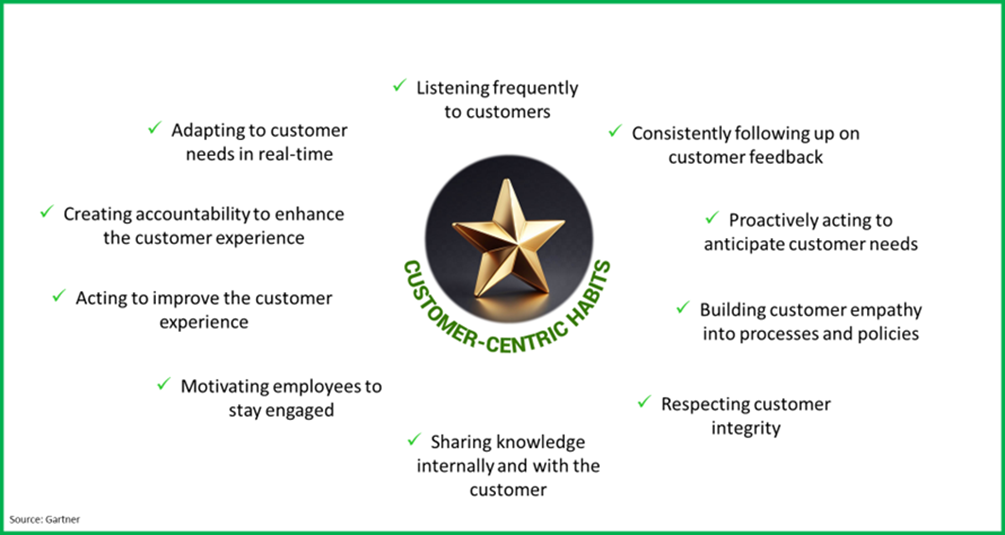
Let’s have a look at what each of these habits involves.
Listening frequently to customers involves actively seeking customer feedback and using it to enhance products and services. Training staff to listen, question, and take action efficiently is crucial. Ignoring customer input can lead to disgruntled customers and a tarnished reputation.
Acknowledging customer feedback and keeping them informed about its usage is essential. Regularly monitoring and acting on feedback ensures a strong feedback loop. Expressing gratitude, following up as necessary, and summarizing actions taken to maintain a strong customer relationship.
Customer-centric companies predict customer needs and offer solutions before customers even recognize these needs. Using data for insights into customer behavior and preferences helps in making informed decisions. Developing and enhancing products and services with customer focus further solidifies this approach.
Building empathy into all processes and policies ensures respectful and caring customer treatment. Staff training to understand and cater to customer needs is vital. Designing products and services aligned with specific customer preferences establishes a deep customer connection.
Respecting customer privacy and safeguarding their personal information is paramount. Establishing clear data handling policies and procedures, training employees, and ensuring transparent data usage are crucial steps. Giving customers control over their data strengthens trust.
Facilitating internal and external knowledge sharing enhances the customer experience. Providing employees with effective information exchange tools and offering customers transparent information about products, services, policies, and procedures fosters mutual understanding.
Training staff to swiftly and effectively solve customer issues empowers them to provide excellent customer service. Employee empowerment for customer-centric decisions, regular feedback, and recognition enhance engagement and performance.
Consistently seeking ways to improve the customer experience based on feedback and data is essential. Measuring and tracking customer satisfaction ensures alignment with expectations. Making customer experience a top organizational priority across all departments strengthens commitment.
Setting clear goals and metrics for success helps in tracking improvements. Holding the company accountable for delivering excellent customer service and consistently enhancing the customer experience maintains focus. Providing employees with resources for achieving customer-centric goals enhances performance.
Being adaptable in real-time to customer demands is crucial. This involves increasing real-time capabilities, analyzing data swiftly for quick responses to unexpected business events, and utilizing data insights to make informed decisions promptly.
These outlined habits collectively define a customer-centric approach. By embracing these practices, businesses can cultivate a customer-centric culture that strengthens customer satisfaction and relationships, ultimately contributing to long-term success.

Exercise 1:1 Customer-Centric Habit Check
• How does our company actively practice this habit?
• Can you share specific examples where this habit is evident in our operations?
• How does this habit contribute to our customer relationships and overall success?
Course Manual 2: Collaborative Learning
Connecting Perspectives for Deeper Insights
In the previous session on adopting a customer-centric strategy, we established a foundation for understanding how focusing on customer needs can contribute to long-term business success. However, it’s important to note that collaborative learning has the potential to enhance our comprehension even further. Collaborative learning benefits from a variety of viewpoints, and your individual perspectives are the different elements that come together as we collectively explore this topic.
The experience of the benefits can be eye-opening. One thing that really stands out is how collaborative learning brings together different viewpoints. Another interesting thing is how it’s made me more empathetic. Working closely with others in learning new subjects or working with change management has made me understand where they’re coming from and appreciate their perspectives including potential barriers to change. It’s like stepping into their shoes and seeing the world through their eyes, which of course also is a good thing in terms of getting closer to our customers.
Principles of Collaborative Learning
Collaborative learning offers several benefits that contribute to a more enriching and effective learning experience. Collaborative learning brings together individuals with varied backgrounds, experiences, and viewpoints. This diversity leads to a broader understanding of topics, as participants contribute unique insights that may not have been considered otherwise.
“As you navigate through the rest of your life, be open to collaboration. Other people and other people’s ideas are often better than your own. Find a group of people who challenge and inspire you, spend a lot of time with them, and it will change your life.” – Amy Poehler
Participants in collaborative learning are actively involved in discussions, group activities, and problem-solving. This engagement enhances retention and understanding of the material compared to passive learning methods. Working with peers to analyze, discuss, and solve problems fosters critical thinking skills. Participants learn to evaluate different viewpoints, make informed decisions, and think more deeply about the subject matter.
Collaborative learning encourages participants to express their thoughts clearly and articulate their ideas to others. This enhances verbal communication skills, essential in education and professional contexts. It fosters social interactions and builds a sense of community among participants. This sense of belonging promotes a positive learning environment and can reduce feelings of isolation.
Collaborating with others on complex tasks develops problem-solving skills. Participants learn to brainstorm, analyze situations, and collectively develop solutions, replicating real-world scenarios. Furthermore, they learn not only from instructors but also from their peers. This peer-to-peer teaching encourages the reinforcement of concepts and a deeper understanding of the subject matter.
The sense of shared responsibility and accountability within a group often leads to increased motivation to participate and contribute actively to the learning process. Collaborative learning encourages the development of teamwork, leadership, negotiation, and conflict-resolution skills – all of which are valuable in professional and personal contexts.
Engaging in discussions and teaching others can lead to better retention of information. Teaching a concept to someone else requires a higher level of understanding, enhancing memory retention.
Overall, collaborative learning creates an environment that mirrors real-world situations, where individuals work together to achieve common goals. It nurtures a deeper understanding of subjects, promotes critical thinking, and equips participants with skills necessary for success in various aspects of life.

Exercise 1.2a: “Two Truths and a Lie”
Case study: A Journey Toward Open Communication Culture
Background:
HubSpot, a pioneering marketing software company, went on a transformative journey to enhance its company culture, placing open communication at the forefront. Recognizing the significance of fostering an environment where ideas flow freely and information is readily shared, HubSpot’s pursuit of an open communication culture has shaped its trajectory and success.
Challenges
HubSpot initially faced challenges associated with siloed communication, where information and ideas were confined within departments. This hindered cross-functional collaboration, stifled innovation, and limited the organization’s capacity to respond nimbly to industry changes.
Transformational Steps
• Cultural Mindset Shift: HubSpot’s leadership recognized the need for a fundamental mindset shift to embrace openness. They acknowledged that transparent communication empowers employees to contribute meaningfully, irrespective of their role or department.
HubSpot initially faced challenges associated with siloed communication, where information and ideas were confined within departments. This hindered cross-functional collaboration, stifled innovation, and limited the organization’s capacity to respond nimbly to industry changes.
Transformational Steps
• Cultural Mindset Shift: HubSpot’s leadership recognized the need for a fundamental mindset shift to embrace openness. They acknowledged that transparent communication empowers employees to contribute meaningfully, irrespective of their role or department.
• Leadership Buy-In: To set the example, HubSpot’s leadership is committed to modeling open communication. The top management, including the CEO and executives, regularly engaged in transparent dialogue, sharing updates, successes, challenges, and even personal anecdotes.
• Information Accessibility: HubSpot invested in platforms and tools that facilitated real-time information sharing. Internal communication channels, such as Slack and an intranet, became hubs for employees to access updates, project developments, and organizational news.
• Regular Town Hall Meetings: HubSpot initiated regular town hall meetings, inviting employees across departments to participate in open discussions. These meetings addressed company updates, strategic goals, and allowed for Q&A sessions, ensuring everyone had a voice.
• Feedback Loops: The company introduced mechanisms for soliciting feedback from employees at all levels. Anonymous suggestion boxes, surveys, and feedback sessions enabled employees to voice their opinions without apprehension.
• Learning from Failure: HubSpot encouraged openness about mistakes and failures. Sharing lessons learned from failures became a means to foster a culture of continuous improvement and learning.
Results
The shift toward open communication unlocked cross-functional collaboration, leading to innovative ideas that might have remained hidden in a siloed environment. Employees felt empowered to contribute insights, regardless of hierarchy, knowing their opinions were valued and heard which facilitated collective problem-solving. Challenges were addressed collaboratively, drawing on diverse viewpoints. The culture of open communication heightened employee engagement and job satisfaction, as employees felt more connected to the company’s vision and direction. Furthermore, HubSpot’s commitment to open communication raised a shared sense of purpose, uniting employees around common goals and values.
HubSpot’s journey underscores the transformative power of open communication in shaping company culture. The company’s commitment to transparency, from leadership to tools and practices, has resulted in a thriving culture of collaboration, innovation, and continuous learning.
Collaborative learning a tool in becoming more customer-centric
As the HubSpot case study illustrated, collaborative learning and open communication holds the potential to fundamentally transform an organization into a more customer-centric entity.

Within the collaborative learning dynamic framework, several shared insights arise. Employees from different departments and roles bring their individual experiences and observations to the table. This collective perspective involves a range of viewpoints that capture the greater details of customer expectations. This shared knowledge serves as a foundation for shaping organizational strategies, ensuring they align closely with customer preferences.
Collaborative learning excels in gathering a variety of viewpoints. It brings together employees from various backgrounds and fields, harmonizing their perspectives. This collaboration leads to a deeper understanding of customer needs that might have been overlooked otherwise. Through this collaborative effort, the organization gains a more comprehensive view of customer insight.
The impact of collaborative learning goes beyond knowledge alone; it extends to the area of informed decision-making. As employees engage in shared learning experiences, they gain a more nuanced understanding of customer behaviors, preferences, and concerns. This perspective guides decision-making, ensuring that organizational actions remain closely aligned with evolving customer expectations.
A notable shift happens in problem-solving. Collaborative learning encourages employees to address challenges with a focus on the customer. This process reflects a commitment to resolving issues from the customer’s point of view.
Through continuous learning, employees stay attuned to shifts in customer needs and preferences. As markets fluctuate, the organization is ready to adjust its strategies promptly, ensuring an ongoing alignment with customer expectations.
In addition to sharing knowledge, collaborative learning supports cross-functional cooperation. It breaks down departmental boundaries and colleagues work together to meet customer needs holistically. This collaboration leads to the creation of multi-layered strategies and initiatives that address a wide range of customer requirements.
At its core, collaborative learning is a channel for an engaged workforce. Employees involved in shared learning experiences feel a heightened sense of value and inclusion in the organization’s customer-centric journey. This elevated engagement translates into a motivated workforce, driven by a genuine
In conclusion, collaborative learning isn’t solely about sharing knowledge – it leads to a shift in perspective. By involving employees in shared learning experiences and supporting a culture of collaboration, organizations experience a transformation. Over time, the foundation of customer-centricity becomes established, influencing various aspects of the organization. This comprehensive change brings together employees, strategies, and culture that genuinely centers around customers’ needs and goals.

Exercise 1.2b: ” Customer-Centric Insights Exchange “
Course Manual 3: Customer Feedback
In this session, we are diving into the world of customer feedback, and trust me, it is way more than just gathering opinions. It is like having a secret map of your audience’s thoughts and feelings. By really listening to what they are saying – their stories, suggestions, and challenges – you can create solutions that truly connect. These insights are highly valuable – they lead you to creating great experiences and forming real bonds.
Today, get ready to see why customer feedback is way more than just a box to tick (the box-tick approach is very common to what I have seen). We are going to dig into how it guides you, like a compass pointing out the spots where you can level up. You will see how quickly responding to feedback can turn customers into advocates of your brand. And you know, this feedback is not just a guide – it is like a starting point for ideas that can lead your business to some pretty unexpected places.
Taking action
Using customer feedback as a roadmap for getting better involves a bit of strategy. It is about listening, analyzing, and taking action on what your customers share. Now let’s have a look at how you can make customer feedback a game-changer for your products, services, and overall business journey.
Encouraging customers to share their thoughts across multiple channels (of course check so that all communication is compliant with your company policy and market regulations) is a key starting point. Make it easy for them to provide feedback through surveys, emails, social media, and reviews. Ensure that feedback mechanisms are accessible on your website and embedded within your products or services. Use different feedback formats like open-ended questions, ratings, and multiple-choice options to capture a wide range of perspectives.
Once you have collected feedback, the next step is to thoroughly analyze it. Regularly review the feedback to identify patterns, recurring themes, and areas of concern. Categorize the feedback based on the nature of the issues – whether they relate to usability, functionality, customer service, or other aspects. Prioritize the feedback by considering its frequency and potential impact on customer satisfaction.
Responding to customer feedback is vital. Acknowledge their input promptly and express your appreciation for their engagement. Make sure they know their opinions are valued by addressing their concerns and suggestions with a genuine sense of empathy.
When going through the feedback, focus on insights that are actionable. Look for feedback that aligns with your business goals and has the potential to bring about meaningful improvements. By focusing on actionable insights, you can concentrate your efforts on changes that will have a tangible impact.
After identifying valuable insights, the next step is to put plans into action. Develop a clear strategy based on the feedback you have collected. Collaborate with relevant teams to make necessary changes to products, services, or processes. Communication is key – let your customers know about the changes you have made based on their feedback. This not only shows that you’re listening but also demonstrates that their opinions are catalysts for real change.
Following implementation, it is crucial to measure the impact of the changes you have made. Keep a close eye on customer satisfaction and track relevant business metrics. If possible, gather feedback again after changes are in place to validate whether these adjustments have effectively addressed customers’ concerns. This continuous feedback loop ensures that you are always refining your approach based on real-world outcomes.
Active Listening

Be Attentive: Pay close attention to what customers are saying, whether it is through written comments, reviews, or direct interactions. Avoid interrupting or rushing the conversation, allowing customers to express their thoughts fully.
Seek Clarification: Ask follow-up questions to clarify any ambiguous or unclear feedback. Show that you’re genuinely interested in understanding their experiences.
Empathize and understand: Put yourself in the customer’s shoes and try to understand the emotions behind their feedback. Show empathy by acknowledging their feelings and experiences.
Paraphrase and Reflect: Summarize their feedback in your own words to demonstrate that you are actively processing their input. Reflect back on their sentiments to show that you’ve understood their perspective.
Take Immediate Action: If possible, address urgent concerns immediately to show that you are responsive to their needs. Even if a comprehensive solution requires more time, provide a quick initial response to let them know you are working on it.
By incorporating these strategies into your approach, you will be able to use customer feedback as a reliable compass to navigate toward continuous improvement and better customer experiences. Active listening not only drives positive change but also builds stronger customer relationships and trust.
Case study: The fall of the typewriter industry
As personal computers and digital word processing gained popularity, typewriters, once a staple, lost relevance due to their limitations in editing, computer-integration, and cost-effectiveness. Despite this challenge, IBM managed to successfully transition by embracing the personal computer revolution and diversifying its offerings. In contrast, many typewriter manufacturers struggled to adapt to the evolving technology landscape. These companies found it difficult to shift from their traditional product lines, leaving them unable to address the changing needs of consumers who were rapidly adopting digital solutions. This inability to shift effectively, in comparison to IBM, further underlines the vital lesson of adaptability in the face of technological disruption. IBM’s ability to navigate the shift allowed the company to maintain its relevance and success in the technology industry, while the typewriter industry’s difficulties showcase the hurdles that companies face when they fail to adapt to a changing market.

Exercise 1.3a: “Adapting to new technology “
From Shortcomings to Success
Through customer feedback, businesses can uncover areas where their products or services may be falling short. For instance, when customers share their experiences and opinions, it becomes apparent where usability issues lie. This could manifest in feedback about confusing interfaces or difficult navigation within a software application, signaling the need for refined user experience design.

Similarly, customers often use feedback to express their desires for additional features or functionalities. Such requests provide insights into gaps between existing offerings and customer expectations. For instance, if a consistent demand for a particular feature emerges, it suggests an opportunity to enhance the product’s capabilities and align it more closely with user needs.
Beyond functionality, feedback can highlight concerns related to performance and quality. Complaints about slow loading times, system crashes, or product defects serve as clear indicators of areas that require immediate attention. These insights guide the company in refining technical aspects and ensuring a seamless experience for users.
Furthermore, customers may use feedback channels to voice their frustrations with customer service experiences. Frequent complaints about unresponsive support or inadequate issue resolution reveal the need for procedural improvements in the customer service department. Addressing these concerns not only rectifies the immediate issue but also strengthens the overall customer experience.
The benefits of promptly addressing these shortcomings are numerous. First and foremost, such responsiveness enhances the overall customer experience. Customers appreciate seeing their feedback taken seriously, leading to improved satisfaction and loyalty. Moreover, positive customer experiences often lead to favorable word-of-mouth recommendations, boosting the brand’s reputation and attracting new customers.
By consistently refining products and services based on customer feedback, businesses gain a competitive edge. They remain agile in adapting to changing preferences and market trends, ensuring they remain relevant and compelling to their audience.
Collecting Customer Feedback: Methods and Pros/Cons
There are various methods to gather customer feedback, each with its own set of advantages and disadvantages. We will go deep into different qualitative and quantitative methodologies in coming sessions but let’s have a look at some examples already now.
Qualitative methodologies
In-depth interviews
Pros: Interviews offer in-depth insights. They can uncover underlying emotions and motivations behind customer feedback.
Cons: Interviews are time-consuming and resource-intensive especially if meeting in person. Analyzing qualitative data from interviews can be challenging and subjective.
Focus Groups or Advisory Boards
Pros: Focus groups or advisory boards bring together a group of participants to discuss a specific topic. They can generate rich insights, facilitate group dynamics, and encourage participants to build upon each other’s ideas.
Cons: It can be difficult to assemble a representative group, and the group dynamics might influence responses. The findings might not be universally applicable.
Feedback Platforms and Online Communities
Pros: Creating online communities or feedback platforms where customers can share ideas and suggestions fosters engagement and a sense of ownership.
Cons: These platforms require ongoing moderation and management. The feedback might be skewed towards the most active users.
Quantitative methodologies
Surveys and Questionnaires
Pros: Surveys allow you to gather specific information and structured data. They can be conducted online or offline, making them versatile and allowing broad geographical spread. They are easy to distribute and provide quantitative insights.
Cons: Response rates can be low, and respondents might provide incomplete or biased answers. Designing effective surveys that capture the right information can be challenging.
Feedback Forms
Pros: These are shorter forms often used for specific interactions, like website feedback or after a customer service call. They’re quick for customers to fill out using any device and can provide immediate insights.
Cons: Feedback forms are limited in scope and might not capture more nuanced feedback. They may not be suitable for capturing feedback on broader experiences.
Social Media Monitoring
Pros: Monitoring social media platforms allows you to capture real-time feedback and customer sentiment. It’s a way to uncover unsolicited feedback and address issues promptly.
Cons: Social media can be noisy, and it might not represent the entire customer base. Negative feedback can be amplified and impact brand perception.
Online Reviews and Ratings
Pros: Online reviews provide public feedback that potential customers can also see. They offer insights into customer satisfaction and areas for improvement.
Cons: Negative reviews can impact brand reputation. Some customers might leave extreme reviews, skewing the overall perception.
User Analytics and Behavior Tracking
Pros: Tracking user behavior on websites or apps can provide insights into how customers interact with your products. It’s especially useful for identifying usability issues.
Cons: It doesn’t directly capture customers’ opinions or thoughts, and it might not reveal the “why” behind their actions.
Remember, the most effective approach often involves using a combination of methods to capture a comprehensive view of customer feedback. Each method has its own strengths and weaknesses, and choosing the right mix depends on your business goals, resources, and the type of insights you are seeking to gain.

Exercise 1.3b: ” Methodologies, sharing experience “

Course Manual 4: Customer Segmentation
Customer segmentation is the practice of dividing a business’s customer base into distinct groups or segments based on shared characteristics, behaviors, preferences, and needs. Instead of treating all customers as a single homogenous group, businesses identify subgroups that have similar characteristics. These characteristics can include demographics (age, gender, location), psychographics (lifestyle, values, interests), buying behaviors (frequency, spending habits), and more. Let’s start this session with discussing why customer segmentation is important. It is also worth noting that customer segmentation has its place in B2B (business-to-business), B2C (business-to-consumer), and even public sector contexts. The ultimate goal of customer segmentation remains the same independent of the industry: to better understand customer needs and tailor offerings to meet those needs effectively.

Why Customer Segmentation Is Important
Customer segmentation is a vital strategy for businesses across industries due to several compelling reasons:
Tailored Personalization: Not all customers are the same. Segmentation allows businesses to create tailored products, services, and marketing strategies that resonate with specific customer groups. This personalized approach enhances customer satisfaction and loyalty.
Deeper Understanding: Segmenting customers provide valuable insights into what drives their behaviors, preferences, and purchasing decisions. This deeper understanding helps businesses make informed decisions about product development, marketing campaigns, and customer engagement.
Effective Marketing: Different customer segments respond differently to marketing messages. By tailoring marketing efforts to each segment’s preferences and needs, businesses can deliver more relevant and impactful campaigns, leading to higher conversion rates.
Competitive Advantage: Businesses that understand their customers better can stand out from competitors. Customized offerings targeted at specific segments create a unique value proposition, attracting new customers and retaining existing ones.
Resource Optimization: Not all customers are equally profitable. Segmentation allows businesses to identify high-value segments and allocate resources, such as marketing budgets and sales efforts, where they are most likely to generate the highest return on investment.
Innovation and Product Development: Insights from customer segments can drive innovation by identifying unmet needs or emerging trends. Businesses can develop new products or refine existing ones based on segment-specific feedback.
Customer Retention: Personalized experiences foster customer loyalty. When customers feel understood and catered to, they are more likely to remain loyal to a brand and become brand advocates.
Efficient Communication: Different customer segments prefer different communication channels. Effective segmentation ensures that businesses use the right channels to reach each group, improving engagement and response rates.
Risk Mitigation: Relying on a single customer base is risky. Diversifying customer segments helps businesses mitigate risks associated with changes in market trends, economic conditions, or consumer preferences.
In the end, customer segmentation is a strategic approach that helps businesses maximize their understanding of their customers and optimize their operations to drive growth, profitability, and overall success. It’s not just about dividing customers but about building meaningful connections and offering value tailored to diverse groups of individuals.

Exercise 1.4a: ” Segmentation snap “

Customer segmentation in different industries and sectors
The approach to customer segmentation varies based on the markets and customers within each sector, let’s have a look at what customer segmentation approach to consider in each area.
Navigating Complexity in B2B
The B2B customer segmentation approach is often multi-layered, driven by complex decision-making processes. Companies divide their customers based on industry, size of organization, purchasing authority, and specific needs. The emphasis is on building personalized relationships that align with the unique goals and challenges of B2B customers which also includes emotional aspects. This requires a deep understanding of the industry landscape, long-term partnership building, and value propositions that resonate with business objectives.
Tapping into Diversity B2C
In contrast, B2C customer segmentation revolves around the diverse preferences and behaviors of individual consumers. The focus here is on demographics, psychographics, and behavior patterns. Businesses in this sector create segments based on age, gender, lifestyle, and purchasing history. The aim is to craft tailored experiences that resonate emotionally with customers, often leveraging mass media and consumer-centric channels. B2C segmentation centers on engaging storytelling, emotional connections, and aligning products with the aspirations of individual consumers.
Customer Segmentation and Balancing Public Interests
When it comes to the public sector, customers are citizens, residents, or other type of stakeholders engaging with governmental services. Segmentation focuses on factors like demographics, geographic locations, and service utilization patterns. The primary objective is to enhance public service delivery, allocate resources efficiently, and promote citizen engagement. Unlike the business sector, the public sector must balance diverse public interests, accessibility, inclusivity, and transparency.
In each sector, customer segmentation serves as a compass, guiding organizations toward better understanding and engagement. The approach varies, reflecting the sector’s inherent complexities and goals. B2B segmentation is characterized by complicated relationship-building, aligning with business objectives. B2C segmentation taps into emotional connections and individual preferences. The public sector, with a focus on public service, seeks to balance diverse needs while ensuring equitable resource allocation. These nuanced approaches demonstrate the adaptability of customer segmentation to diverse contexts, ultimately shaping more effective strategies for engagement and growth.
Case study: Metro Trains Melbourne Safety around Trains campaign
Background: I am sure most of you have come across this enjoyable yet impactful campaign previously, I think it is a relevant example of identifying and understanding a target audience.
The “Dumb Ways to Die” campaign, initiated by Metro Trains Melbourne in November 2012, aimed to promote rail safety through a comedic approach that resonated with a younger audience. The campaign was developed by the advertising agency McCann Melbourne.
Impact: To mention some, the video’s viral success on YouTube and social media led to over 127 million pledges for safer conduct around trains and up to 20% drop in train-related accidents. This achievement earned the campaign 28 Cannes Lions awards and global recognition.
The campaign’s aim was to engage an audience that typically does not want to hear safety messages, and most likely Metro Trains Melbourne used some form of customer segmentation or market research to identify the best way to reach this audience. It illustrates in a nice way how customer segmentation is a valuable tool for any organization to better understand its target audience and tailor their marketing efforts accordingly.
Customer Segmentation Process
So where to start? The easiest way to approach it is to follow a customer segmentation process step by step. The process of customer segmentation involves a series of well-defined steps aimed at efficiently categorizing a customer base into groups that share common features. Here is an overview of the customer segmentation process.
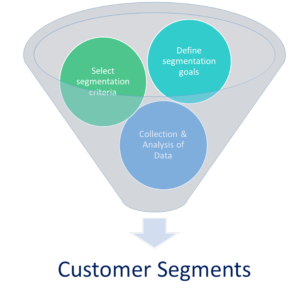
In the initial stage, gather and analyze customer data about demographic details, purchase history, behaviors, and preferences.
The next step is to clarify the precise objectives of the customer segmentation strategy, whether it is boosting marketing efficiency, elevating customer satisfaction, or driving sales growth.
Choose the specific criteria or variables that will be utilized for the segmentation process, such as demographics, psychographics, behaviors, or needs.
Utilize the collected data and selected variables to craft distinct customer segments, each characterized by unique attributes and requirements.
Once the customer segments are in place, ensure to validate and refine the segments. Put the created segments to the test by evaluating them against real-world data and customer input. Refine segments as necessary to ensure accuracy and efficacy.
Now it is time to formulate tailored marketing strategies and/ or value propositions. Develop precise marketing strategies for each customer segment, taking into account their individual personalities and needs. This encompasses tailored messaging, offers, and campaigns.
Put the marketing strategies into action and continually monitor segment performance. Keep an eye on customer behavior, making adjustments to strategies as required.
By following these systematic steps, businesses can proficiently segment their customer base and calibrate their marketing efforts to address the distinct needs of each segment.
Customer Segmentation & Challenges
Before getting on with customer segmentation, there are some challenges that are good to be aware of as we then are better equipped to prevent it from happening.
Data quality plays a central role in effective customer segmentation. Inaccuracies within data sources can have a ripple effect on the entire process, leading to misguided outcomes. To tackle this challenge, businesses should prioritize accurate, relevant, and bias-free data. This ensures that the foundation on which segments are built remains sturdy, reducing the risk of inaccuracies.
A challenge arises with overgeneralization or relying too heavily on one or a few characteristics. This can result in stereotyping and a lack of personalization, diminishing customer experience. To address this, businesses can utilize multiple segmentation criteria and diverse data sources. This approach refines segmentation, creating more specific and targeted customer groups.
Inaccurate targeting and messaging can come from ineffective customer segmentation. To mitigate this, it is important to validate customer segments by testing them against real-world data and customer feedback. Refinement based on this validation ensures accuracy and effectiveness.
Flexibility is key when dealing with dynamic market conditions. A challenge here is to ensure that the segmentation approach remains adaptable. To tackle this, businesses should be willing to adjust their strategy and employ multiple segmentation criteria. This helps maintain alignment with shifting market dynamics.
Customer feedback is invaluable in the segmentation journey. Ignoring it can lead to misguided strategies. To address this challenge, continuous tracking and analysis of customer behavior is crucial. Adapting strategies based on this feedback ensures that segments stay relevant and effective.
Privacy concerns arise when collecting and using customer data for segmentation. Striking a balance between data utilization and ethical responsibility is essential. Businesses should ensure compliance with data protection regulations, transparently communicate data usage practices to customers, and handle data with care.
In summary, understanding and navigating challenges in customer segmentation are essential for success. By addressing these challenges head-on, businesses can effectively implement customer segmentation strategies, enhancing their marketing efforts and achieving better results.
Case study: Stimorol target audience
Stimorol, a chewing gum brand under Mondelez International, launched a campaign in 2013 aiming at teenagers, but it faced failure due to a lack of resonance with the intended audience. The campaign featured “Mr. Stimorol,” representing the brand’s cool image, yet teenagers deemed the character outdated and unrelatable.
To save the situation, Stimorol conducted additional market research, discovering that their true target audience was young adults aged 18-24, not teenagers. In response, they crafted a new campaign centered around “The Gum Whisperer,” a contemporary and relatable character. This shift proved successful, boosting Stimorol’s market share among young adults.
This case illustrates the consequences of mistargeting and the significance of accurate customer segmentation. It emphasizes the important role of ongoing market research and the ability to adapt strategies to effectively connect with the distinct preferences of each segment.

Exercise 1.4b: ” Real-life scenarios ”
• A software company that specializes in providing CRM solutions for small and medium-sized businesses.
• A trendy fashion brand that offers sustainable clothing
• A public library system aiming to enhance community engagement and modernize its services in an increasingly digital environment

Course Manual 5: Persona Development
We are now familiar with the concept of customer segmentation, the practice of classifying our target market into distinct groups based on shared characteristics. But what comes next? This is where persona development enters the scene.
Imagine if you could bring those segments to life, not just as data points but as relatable, almost familiar individuals. This is precisely what persona development accomplishes. In this session we will explore how personas take customer segmentation a step further, transforming abstract data into characters with personalities, desires, and challenges. These personas are not just generic placeholders; they’re accurately crafted representations of real people, offering insights that exceed demographics.
Importance of Persona Development
Persona development is not just a supplementary step; it is highly important when developing successful marketing strategies. While customer segmentation provides a foundational understanding of your audience, personas take it several steps further by creating rich, relatable characters that exemplify the motivations, behaviors, and preferences of specific segments.
Personas allow you to craft messages that resonate deeply with each segment’s motivations and pain points. This precision transforms your communications from generic to resonant, capturing your audience’s attention and fostering engagement.
Personas act as guiding stars for product development. By understanding the goals, needs, and challenges of each persona, you can tailor your offerings to align with what your customers truly desire, leading to products and services that satisfy real needs.
Personalization is the key to an exceptional customer experience. Personas enable you to tailor interactions, content, and touchpoints according to the preferences of different segments, resulting in higher satisfaction and deeper engagement.
With limited resources, it is crucial to focus on areas that will lead to optimal returns. Personas help you identify which segments offer the greatest potential and direct resources toward them, maximizing your marketing impact.
Furthermore, personas humanize data, transforming abstract segments into relatable individuals. This supports empathy within teams, leads to a deeper understanding of your customers, and encourages customer-centric decision-making.
In summary, persona development bridges the gap between raw data and actionable insights. It empowers you to connect on a human level, to address real needs, and to communicate in ways that truly resonate. By understanding the motivations, behaviors, and preferences of each persona, you can create marketing strategies that not only drive results but also foster genuine connections with your audience.
The Persona Development Process

Data Collection: Gather information about your customer segments from various sources such as market research, surveys, interviews, and analytics. This data should encompass demographics (age, gender, location, etc.), psychographics (interests, values, lifestyles), behaviors (buying habits, interactions), and pain points (challenges they face).
Identification of Key Characteristics: Analyze the collected data to identify commonalities and patterns within each customer segment. Look for shared motivations, goals, preferences, and challenges that define each group.
Creation of Detailed Profiles: For each customer segment, craft a detailed persona profile that goes beyond the surface. Give your persona a name, age, occupation, and any other relevant demographic details. Then go deeper into their psychological and behavioral aspects, including:
• Behaviors: How do they interact with your brand? What channels do they use? What content do they engage with?
• Motivations and Goals: What are their aspirations? What drives their decisions? What do they hope to achieve through your products or services?
• Preferences: What type of messaging resonates with them? How do they prefer to receive information? What factors influence their buying decisions?
• Challenges and Pain Points: What obstacles do they face? What problems do they need solutions for? How can your products or services alleviate their pain points?
Visualization and Refinement: Consider adding a visual representation to your persona profiles. This could be a stock image or an illustration that captures the persona’s essence. Additionally, refine the persona details by validating them with data, customer feedback, and stakeholder input. This ensures that your personas are accurate and representative.
Integrating Personas into Strategy: Integrate your personas into your marketing and business strategies. Use them as touchstones when creating messaging, designing products, planning campaigns, and developing customer journeys. Every decision you make should align with the personas’ motivations and preferences.
Continuous Iteration: Personas are not static; they should evolve as your audience and market change. Regularly update and refine your personas based on new data and insights. This keeps your marketing strategies aligned with current customer behaviors and preferences.
Cross-Functional Collaboration: Share your persona profiles across your organization. Make sure that everyone involved in marketing, product development, sales, and customer service understands and empathizes with these personas. This promotes customer-centric decision-making throughout your company.
Remember that persona development is an ongoing process that requires a combination of data analysis, creativity, and empathy. The goal is to create accurate and detailed representations of your target customers, helping you better understand their needs, motivations, and behaviors so you can tailor your strategies to resonate with them effectively.
Case study: Airbnb from mattresses to global phenomenon
Airbnb, originally known as “AirBed & Breakfast,” was founded in 2008 by Brian Chesky, Joe Gebbia, and Nathan Blecharczyk. The company’s inception can be traced back to a simple idea born out of necessity and inventiveness. Chesky and Gebbia faced high rent costs for their San Francisco apartment. Identifying a gap during a design conference, they offered air mattresses for lodging, birthing the notion of “AirBed & Breakfast.”
This led to a basic website advertising their temporary “accommodation.” Later joined by Blecharczyk, a tech-savvy friend, they expanded beyond their living room, launching Airbnb’s global peer-to-peer lodging platform.
Let’s explore how persona development played a crucial role in Airbnb’s remarkable success story and contributed to shaping Airbnb into a global travel phenomenon.
Airbnb used customer segmentation which enabled them to develop tailored offerings to address different customer needs. They provided a range of accommodation options, from budget-friendly stays to luxury experiences, ensuring that each segment found something suitable on their platform.
Airbnb went beyond demographics to create detailed personas of their target segments. This transformed abstract data into relatable and humanized profiles, making it easier for the company to connect with its audience on a deeper level. The personas helped Airbnb employees across departments empathize with their users. Instead of treating users as faceless customers, employees could relate to the personas and understand their needs, leading to more customer-centric decision-making.
Personas provided a tangible framework for decision-making. Airbnb’s marketing, product development, and customer service strategies were all informed by the personas. This alignment ensured that every aspect of their business was geared towards meeting the needs of their diverse user base. Airbnb used personas to design experiences that resonated with different traveler types. For instance, they highlighted unique experiences for “The Experience Seeker” persona and affordability for “The Budget Traveler.” This personalization enhanced customer engagement and satisfaction.
By understanding the concerns and preferences of customers, Airbnb could address potential pain points in their marketing materials, reassuring users that their unique needs were being considered.
The combination of customer segmentation and persona development allowed Airbnb to create a platform that felt tailor-made for each individual user. This personalized approach resonated strongly with travelers, leading to increased trust, engagement, and loyalty. By acknowledging the diverse needs of their audience and humanizing their data, Airbnb was able to build a community of hosts and guests who felt understood and valued. This, in turn, played a significant role in Airbnb’s impressive journey in becoming a global travel phenomenon.
Persona development watchouts
While persona development can be very beneficial, there are also challenges and potential pitfalls to be aware of. Here are some to consider:
Overgeneralization: Creating overly broad personas that encompass too many characteristics can lead to ineffective strategies. It’s important to strike a balance between detail and generalization to ensure that personas remain actionable.

Assumption-Based Personas: Relying on assumptions or stereotypes without solid data can result in inaccurate personas that don’t reflect the actual behaviors and preferences of your target audience. Also, developing personas based only on data that confirms preexisting assumptions can lead to biased personas that don’t accurately represent your entire audience.
Ignoring Negative Personas: A negative persona, also known as an exclusionary persona, is a representation of an individual or group that doesn’t align with your target audience or ideal customer profile. While traditional personas focus on identifying and understanding the characteristics of your primary audience, negative personas are designed to help you recognize and avoid engaging with individuals who are not a good fit for your product, service, or business.
Static Personas: Failing to update personas can render them outdated and irrelevant. Customer behaviors, preferences, and market dynamics change over time, so it’s essential to continuously review and refresh your personas. Equally, market dynamics can shift rapidly, and customer behaviors can evolve. Failing to anticipate and adapt to these changes can result in strategies that no longer resonate.
Limited Research: Inadequate research can result in personas that lack depth and nuance. Robust research is crucial for capturing accurate insights into customer motivations, behaviors, and pain points. Relying too heavily on one type of data (quantitative or qualitative) can lead to skewed personas. A balanced approach that incorporates both data types is ideal.
Lack of Alignment: If personas aren’t shared and understood across your organization, they won’t effectively guide decision-making. Ensure that all teams involved in strategy, marketing, and product development are on the same page.
Personas as a Sole Focus: Relying solely on personas can lead to tunnel vision. While personas provide valuable insights, they should be used in conjunction with other data sources and methodologies to develop a comprehensive strategy.
Lack of Feedback: Developing personas in isolation from real customers can lead to blind spots. Regularly seek feedback from actual customers to validate and refine your personas.
Prioritization Issues: Not all personas are equally valuable. Prioritizing personas based on their potential impact and alignment with your business goals is essential to efficient resource allocation.
Excessive Complexity: Overloading personas with too much detail can hinder their usability. Keep personas focused on the most relevant information for decision-making.
By being aware of these challenges and pitfalls, you can approach persona development with a balanced perspective, ensuring that your personas are accurate, actionable, and aligned with your marketing and business strategies.

Exercise 1.5: “Designing Personas”
• Target Audience: Patients with chronic conditions, healthcare professionals, and caregivers.
• Considerations: Pain points of patients, medical professionals’ needs, and medication adherence challenges.
• Target Audience: Small and medium-sized businesses, tech decision-makers, and IT managers.
• Considerations: Business pain points, technological challenges, budget constraints.
• Target Audience: Health-conscious consumers, busy professionals, and parents.
• Considerations: Snacking habits, dietary preferences, convenience factors.
Course Manual 6: Customer Journey Mapping
I often think about my experiences as a customer both professionally and on a personal note, and I bet you do too. Whether it is the joy of finding that perfect product or the frustration of a process that just doesn’t make sense, we have all been there. In this session, we are going to dive into customer journey mapping. This is not just about business strategies or charts; it is about understanding real human experiences and emotions. It’s about us, as customers, and how we can, in our professional capacities, make those journeys better for others.
A customer journey can be described as the complete sequence of experiences a customer undergoes when interacting with a business, brand, or service. It charts the path from the very first point of awareness, all the way through engagement, purchasing, post-purchase interactions, and potentially to loyalty and advocacy.
Customer’s Perspective

Adopting a customer’s perspective builds empathy. It allows businesses to not just address what customers are doing, but to comprehend why they are doing it, thus leading to deeper connections and more targeted interventions.
Mapping the customer journey highlights areas where customers face challenges, uncertainties, or frustrations. By identifying these pain points, businesses can re-evaluate their offerings to better cater to customer needs. For instance, if customers consistently struggle with a product’s setup process, it might indicate a need for clearer instructions or a more user-friendly design.
Every interaction a customer has with a brand is a touchpoint. By mapping and analyzing these, businesses can refine each one to ensure it provides value. For example, if the journey map reveals that customers often abandon online shopping carts due to a complicated checkout process, simplifying this process can lead to higher conversions.
The feedback loop generated from understanding the customer journey can guide product development. By knowing what customers appreciate and what they don’t, businesses can fine-tune product features to more closely align with user preferences.
Customer journey mapping can uncover inconsistencies in service delivery across various channels. By streamlining these services based on the insights, businesses can ensure customers receive consistent and high-quality service, whether they’re interacting online, over the phone, or in person.
By understanding the different stages and emotions a customer goes through, businesses can tailor their offerings. For instance, knowing that a particular segment of customers values eco-friendly products can lead to the development of a sustainable product line.
Gaps in the customer journey are areas where there’s a disconnect between what the customer expects and what they experience. Identifying these gaps gives businesses the chance to bridge them, ensuring a more coherent and satisfying journey for the customer.
Instead of waiting for complaints, customer journey mapping allows businesses to be proactive. By predicting areas where customers might face challenges, businesses can proactively address these, enhancing the overall experience.
Customer journey mapping highlights areas of opportunity and provides actionable insights to enhance products, services, and the overall customer experience. When applied effectively, it can lead to offerings that not only meet but exceed customer expectations, fostering loyalty and positive brand advocacy.
Touchpoints

The emotional component of a customer’s journey is vital. Emotions shape perceptions, influence decisions, and, ultimately, determine loyalty. Recognizing the emotional highs and lows in a journey allows businesses to elevate positive feelings and mitigate negative ones.
The sum total of touchpoints and emotions results in the overall experience a customer has with a business. Positive experiences lead to repeat business, referrals, and brand advocacy, while negative ones can lead to churn and unfavorable word-of-mouth.
Negative Touchpoints & Pain Points
A negative touchpoint is an instance where a specific interaction falls short of the customer’s expectations, resulting in dissatisfaction. For example, if a customer finds a company’s website difficult to navigate, the website becomes a negative touchpoint.
Pain points are broader challenges or frustrations that customers experience throughout their journey with a product or service. They can be identified through multiple negative touchpoints or even just one significant one.
Pain points are essentially the underlying issues or problems that give rise to negative touchpoints. For example, a customer may find that a brand’s customer service is consistently slow, making wait time a pain point. Various touchpoints, like multiple instances of long hold times during calls or slow email responses, reinforce this pain point.
In summary, while negative touchpoints are specific instances of customer dissatisfaction, pain points represent broader challenges or frustrations that might be identified through one or more negative touchpoints. Think of negative touchpoints as the symptoms and pain points as the underlying conditions causing those symptoms.
Understanding where and why customers face challenges can be invaluable for a business’s strategy. It guides decision-makers in areas ranging from product tweaks to customer service improvements, ensuring the brand remains in alignment with customers’ needs and desires. Understanding these pain points often leads to innovation.

Exercise 1.6a: “Touchpoint recall ”
Gaps in the Customer Journey
Gaps in the customer journey refer to breaks, inconsistencies, or missing elements in a customer’s experience with a brand or service. These gaps are often the points where a customer’s expectations aren’t met, causing friction, confusion, or dissatisfaction.
Imagine a story with missing chapters; while you might understand the beginning and the end, the missing pieces can make the entire narrative feel disjointed or incomplete. Similarly, when a customer interacts with a business, they have a certain set of expectations based on their previous experiences, the brand’s promises, or industry standards. A gap emerges when there’s a noticeable difference between what the customer expects and what they actually experience.
 For instance, a customer might find an advertisement for a product compelling, but when they visit the website to purchase it, they can’t find adequate information about the product. Or perhaps after purchasing a product online, there’s no easy way to get customer support or track the shipment. These are gaps in the journey.
For instance, a customer might find an advertisement for a product compelling, but when they visit the website to purchase it, they can’t find adequate information about the product. Or perhaps after purchasing a product online, there’s no easy way to get customer support or track the shipment. These are gaps in the journey.
Gaps can also be emotional. If a brand promises luxury and exclusivity but its customer service is impersonal or its purchase process is cumbersome, it creates a disconnect between the emotional experience the customer expects and the one they receive.
Identifying and addressing these gaps is crucial for businesses. Left unattended, these gaps can lead to lost sales, diminished brand loyalty, and negative word of mouth. On the other hand, understanding where these gaps exist and bridging them ensures a more seamless and satisfying customer journey.
Case study: Customer Experience
Let’s have a look at a video clip where Professor Levav at Stanford Graduate School of Business, shares his view on customer experience illustrating this element of the customer journey.
Customer Touchpoints
As we have just seen, customer journey mapping is a tool that helps businesses visualize these interactions from the customer’s perspective.
By mapping out the customer journey, businesses get a clear picture of how customers perceive each touchpoint. This provides an invaluable insight: it reveals areas that may be confusing or frustrating to the customer, as well as those that are working well.
With this knowledge, businesses can refine their processes. For instance, if customers find a checkout process tedious, businesses can streamline it. If product information is lacking or unclear, it can be made more comprehensive and accessible. And if there are bumps or abrupt changes between interactions—like moving from in-store consultations to online support—efforts can be made to smoothen these transitions.
The result? An improved customer experience. When interactions are straightforward, relevant, and smooth, customers have a better, more memorable experience with the business.
Customer Journey Design

• Define the Scope: Decide on the specific journey you want to map. Is it for a particular product, a service, or perhaps an aspect of your brand? Determine if you’ll focus on a general customer journey or if you’ll cater to a specific persona.
• Research and Gather Data: To accurately capture the journey, collect data through methods like surveys, interviews, and observation. Understand the customer’s behavior, preferences, pain points, and feedback.
• Identify Key Phases: Break down the journey into main stages, such as Awareness, Consideration, Purchase, Use, and Loyalty. This provides a structured flow of the customer’s progression.
• List Touchpoints: At each stage, identify where and how the customer interacts with your brand. This could be through a website visit, an advertisement, a retail store experience, customer support interactions, and more.
• Capture Emotions and Perceptions: Alongside each touchpoint, note how the customer might feel or what they might think. This gives insights into their emotional journey and helps in identifying moments of delight or frustration.
• Highlight Pain Points and Opportunities: Use the gathered data to pinpoint challenges customers face or areas of dissatisfaction. Then, identify opportunities where you can enhance the experience.
• Visualize the Journey: Use diagrams, flowcharts, or dedicated mapping tools to create a visual representation of the journey. This aids in comprehensive understanding and collaboration.
Let’s have a look at an example of how a customer journey may be illustrated and which elements to include.
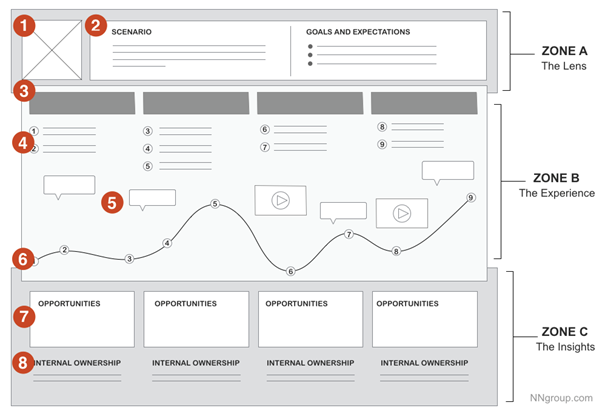
Source: NNgroup.com
Zone A: This area establishes the boundaries for the map by identifying (1) a specific persona (the “who”) and (2) outlining the situation or scenario under consideration (the “what”).
Zone B: This central region of the map illustrates the journey’s experience, typically broken down into (3) touchpoints. It captures the user’s (4) activities, (5) thought processes, and (6) emotional responses (positive or negative), which can be enriched with quotations or video clips from research.
Zone C: The content of this zone can change depending on the business objective being addressed by the map. It may detail the insights and challenges identified and highlight (7) areas of opportunity for future focus. It can also indicate (8) who within the organization takes responsibility for these areas.
Once you have finalized your customer journey, don’t forget that customer journeys should not be static. As you introduce changes or as customer behaviors evolve, revisit and update the map to reflect current realities. By systematically designing a customer journey, businesses gain a holistic view of their customers’ experiences, enabling them to enhance touchpoints, address challenges, and foster positive customer relationships.

Exercise 1.6b “Pain points & Possibilities”

Course Manual 7: Customer Experience (CX)
Today, we will discuss Customer Experience (CX) which refers to the perceptions, emotions, and reactions a customer has throughout all their interactions with a brand or organization. It includes every touchpoint a customer encounters, from their first exposure to the brand (such as through advertising or word of mouth) to the purchase and use of a product or service, and even post-purchase support or follow-up.

CX Significance
Rather than focusing solely on a product’s features or a specific service’s output, CX emphasizes the broader journey a customer undertakes with a brand. It considers factors like the ease of navigating a website, the helpfulness of customer support, the efficiency of the purchase process, and the overall satisfaction derived from using a product or service.
In today’s competitive business environment, CX has become a pivotal differentiator for companies. A positive customer experience can lead to increased loyalty, repeat business, and positive referrals, while negative experiences can lead to brand switching, poor reviews, and a poor reputation.
CX is the cumulative impact of all the interactions a customer has with a brand, spanning from the moment they first learn about it, through the purchase and usage of its products or services, and onto the post-purchase support and potential advocacy or disengagement. It is a holistic representation of a customer’s journey with a brand, capturing every touchpoint, emotion, and perception.
CX Components
• Touchpoints: Every point of contact, whether it is through a website, a physical store, a congress, or any other channel.
• Emotions: The feelings that arise in customers at each interaction, which contribute significantly to their overall perception and loyalty.
• Perceptions: The beliefs or views formed about a brand based on the cumulative experience.
Embracing a well-curated customer experience can result in increased customer loyalty, higher retention rates, and positive word-of-mouth referrals. Conversely, neglecting CX can lead to customer churn, negative reviews, and a decline in brand reputation.
Dimensions of CX
• Consistency: Ensuring uniformity in experience across all channels, from online to offline.
• Personalization: Tailoring interactions to suit the unique preferences and histories of individual customers.
• Responsiveness: Being agile in addressing customer inquiries, complaints, or feedback.
• Simplicity: Making processes straightforward and intuitive, minimizing friction or hurdles.
• Anticipation: Proactively meeting and exceeding customer needs, sometimes before they even realize those needs.
A successful CX strategy integrates feedback mechanisms at every touchpoint, enabling continuous improvement. By using advanced analytics and customer insights, businesses can anticipate future needs, tailor their offerings, and ensure that they are always evolving in a manner that resonates with their customer base.
In a time where customer expectations are constantly evolving, staying ahead can be a challenge. This requires a seamless blend of innovative technology, skilled personnel, and a company culture that places the customer at its core.
In summary, CX is not just about transactions or support interactions. When executed well, it transforms customers from plain transactional entities to brand advocates, and businesses from mere providers to industry leaders.

Exercise 1.7a: “The First Impression”
CX vs Customer Journey

In terms of definition, Customer Journey refers to the specific path or sequence of interactions that a customer follows with a brand, from their initial awareness or discovery, through consideration, decision, and post-purchase interactions. It is essentially a roadmap of a customer’s touchpoints with a brand over a particular period.CX, on the other hand, encompasses the broader perceptions, emotions, and reactions a customer has throughout all their interactions with a brand. It is the cumulative impact of multiple journeys and touchpoints over time, leading to an overall sentiment or feeling towards a brand.
The Customer Journey scope typically focuses on specific stages or steps, often visualized in a linear or cyclical map. It could be specific to buying a single product, signing up for a service, or interacting with customer support.
CX scope involves the entirety of a customer’s relationship and history with a brand, from beginning to end. It is more holistic, taking into account every interaction, sentiment, and perceived value.
The Customer Journey purpose aims to identify and understand specific interactions, pain points, and opportunities at each stage. Brands often map out customer journeys to optimize specific processes or touchpoints.
CX’s purpose is aimed at understanding and enhancing the overall sentiment and relationship between the customer and the brand. Improving CX involves addressing pain points, enhancing positives, and fostering loyalty across all journeys and touchpoints.
In summary, while the customer journey is about the steps or interactions in a specific process, CX is about how those steps and other interactions make a customer feel about the brand as a whole. Both concepts are crucial for businesses aiming to understand and improve their relationships with customers.
Understanding CX
There are several methods to gain valuable insights into this area. At the foundation of CX understanding are surveys and feedback forms. These tools, whether as post-purchase surveys, email feedback forms, or in-app questionnaires, serve as primary channels to capture customers’ thoughts and sentiments about their brand interactions.
Yet, sometimes, a deeper dive is necessary. This is where one-on-one interviews come into play. They allow businesses to tap into the nuanced experiences, motivations, and pain points of their customers, providing a depth that standardized surveys might miss. However, not all insights come from direct queries. Observing customers in action, particularly through usability testing, can shine a light on potential obstacles or points of friction as they navigate digital platforms or physical spaces.
The digital age has also amplified the importance of social media monitoring. By tracking mentions of a brand across platforms such as Twitter, Facebook, and Instagram, businesses can garner unsolicited opinions, both positive and negative. Similarly, platforms hosting online reviews and ratings, like Google or Yelp, serve as treasure troves of customer sentiments.
An often-cited metric in the CX world is the Net Promoter Score (NPS). By gauging the likelihood of customers recommending a brand to others, businesses get a thermometer-like reading of satisfaction. Equally telling are interactions with customer support channels. Whether it is through calls, chats, or emails, recurring issues or concerns can offer insights into broader CX challenges.
Journey mapping offers a bird’s eye view, visualizing the path customers traverse from initial discovery to post-purchase. It is a tool that not only pinpoints interactions but also potential pain points along the way. Meanwhile, real-time insights can be collected from feedback boxes implemented on digital platforms, allowing customers to leave immediate comments.
Gathering insights is not solely about looking inward. Competitor analysis offers an external perspective, helping businesses discern their CX strengths and weaknesses in the larger industry context. It is also crucial to consider feedback from the frontline, as staff like salespeople or service representatives often possess untapped insights from their daily customer interactions.
Analytical tools, such as Google Analytics, further elevate our understanding by providing data on user behavior, revealing patterns that might not be immediately evident. Finally, an inward gaze at customer churn can unravel the reasons behind departures, shedding light on CX facets that might need enhancements.
In sum, delving deep into customer experience is an complicated process, blending direct feedback with observational and analytical approaches to paint a holistic picture of a brand’s relationship with its customers.
Case study: Customer Experience Management Explained
Let’s watch this short video from Eye On Tech which provides a simple overview of CX management. Customer experience management (CEM or CXM) involves systematic approaches to optimize interactions between a customer and a business, aiming to enhance customer loyalty and boost revenue. A successful strategy involves understanding the customer, mapping their journey, fostering emotional connections, and collecting their feedback. (source: youtube/Eye On Tech).
Other CX considerations
One of the foundational concepts underscoring the importance of customer relationships is Customer Lifetime Value (CLV). While many discussions around customer interactions focus on immediate gains, CLV urges businesses to adopt a longer-term perspective. It is not merely about the present transaction but the projected series of transactions over the customer’s lifetime association with a brand. By understanding and optimizing for CLV, organizations can more deeply appreciate the enduring financial ramifications of positive CX on their financial health.

In today’s rapidly evolving digital age, we cannot discuss CX without acknowledging the transformative role of technology. While traditional tools like Google Analytics give insights into customer behaviors, we are witnessing an era where Artificial Intelligence, chatbots, and personalized marketing strategies are redefining engagement norms. These technological advancements not only optimize interactions but also ensure that experiences are tailored, responsive, and predictive, meeting customers at their points of need.
Parallel to the customer’s journey with a brand is the journey of the brand’s employees. The Employee Experience (EX), while often overlooked, is basically tied to CX. Employees who are engaged, motivated, and feel valued are better positioned to deliver exceptional service. It is a symbiotic relationship: a satisfied employee often translates to a satisfied customer, underscoring the importance of nurturing internal stakeholders.
The modern consumer is not just an isolated entity, making purchasing decisions in a vacuum. They are increasingly informed, conscious, and driven by values. Ethical considerations, therefore, have come to the forefront of CX. Customers now evaluate brands based on their ethical stances, sustainability efforts, commitment to corporate social responsibility, and ethical sourcing practices. They align themselves with businesses that reflect their values, ensuring that their money supports causes and practices they believe in.
The world today is more interconnected than ever, making it essential for brands to recognize and cater to diverse customer needs. Globalization means businesses often cater to a multicultural audience with varying preferences, values, and expectations. Tailoring CX to these diverse needs is not just good practice; it is a necessity. It ensures inclusivity, relevance, and resonates with a broader audience base, fostering global loyalty.
Finally, while many brands have now understood the value of gathering feedback, it is the application of this feedback that’s paramount. This is where the idea of the ‘feedback loop’ comes in. It is not enough to just know what customers think or feel. That feedback needs to be analyzed, understood, and integrated back into the business processes, refining and elevating CX continuously. It is an ongoing cycle of listening, understanding, and implementing, ensuring that businesses remain agile and responsive to their most valuable stakeholders: their customers.
In essence, understanding and optimizing Customer Experience is a multi-faceted effort, linking financial metrics with emotions, technology, ethics, and continuous improvement. By adopting a holistic approach, businesses can truly make themselves customer-centric, fostering loyalty, advocacy, and sustainable growth.

Exercise 1.7b: “Future CX glimpse”

Course Manual 8: Customer-Centric Innovation
In this session, we will explore the concept of customer-centric innovation or co-creation which is a collaborative approach to product or service development where businesses actively engage and involve their customers in the design, refinement, and innovation process. Instead of creating products or services in isolation and then offering them to the market, companies that adopt co-creation seek input, feedback, and ideas directly from their end users. This strategy often results in solutions that are more tailored to actual customer needs.
Co-creation – Why it matters

Tapping into the collective intelligence of a diverse group (customers, employees, partners) can lead to a broader range of ideas and solutions. Different perspectives can spark creativity, leading to novel solutions that might not have been identified within the confines of a traditional model.
By involving the end-users or customers in the creation process, businesses increase the likelihood that the final product or service meets real-world needs and desires. This can result in increased customer satisfaction and potentially better market adoption.
Engaging with stakeholders early in the development process can help identify potential issues, barriers, or misconceptions. This early feedback can be invaluable in refining the offering, reducing the risk of market failure or costly post-launch modifications.
Co-creation could also include a deeper emotional connection between brands and their stakeholders. Customers, when actively involved in the creation process, tend to develop a sense of ownership, pride, and loyalty toward the product, service, or brand.
Through iterative feedback loops and collaborative efforts, the development process can often be accelerated. Real-time feedback allows for quicker adjustments, reducing the time traditionally spent on extensive post-development testing or revisions
While co-creation might involve costs in terms of setting up platforms or conducting collaborative sessions, it can lead to savings in the longer run. By reducing the likelihood of product failures, costly redesigns, or extensive marketing efforts to correct misaligned products, co-creation can be more cost-effective.
Companies that engage in co-creation are often perceived as more customer-centric and open. This can lead to positive brand perception, setting the company apart in competitive markets.
In rapidly changing markets, co-creation allows companies to be more adaptive and responsive. Regular interactions with stakeholders ensure that businesses remain aligned with evolving needs and preferences.
Co-creation is not limited to customers. Engaging employees in the process can increase job satisfaction, and tap into the expertise that resides within the organization. It also offers businesses a unique opportunity to learn more about their customer base, market trends, and potential areas of innovation. It’s an ongoing education that can inform future strategies and decisions.
Case Study: Co-Create IKEA
I thought it was about time to introduce a case study of a Swedish company. In 2018, IKEA introduced “Co-Create IKEA”, a digital platform inviting customers to collaborate on new products. The platform concentrates on:
• Collecting product ideas from customers
• Organizing IKEA Bootcamps for entrepreneurs
• Partnering with university students for product solutions
• Engaging with global innovation labs
Successful design suggestions might lead to IKEA licensing the idea or investing in its future development. This offers designers the chance to showcase their creations through a leading furniture retailer. Thousands have submitted ideas, with some even progressing to open-source furniture solutions. Contributors whose ideas are selected can receive cash rewards and access to IKEA’s test labs and prototype shops. This co-creation strategy leverages crowd-sourced insights for product innovation, giving IKEA a competitive edge while fostering a loyal customer community. (Source: Braineet.com)
Co-Creation Navigation
At the core of successful co-creation is the principle of openness. It revolves around creating an environment where participants feel encouraged to share their insights, express doubts, and voice opinions. This level of transparency fosters mutual understanding, ensuring everyone appreciates the contributions made by every stakeholder.
The power of co-creation comes from its ability to unite a range of voices. Each participant, with their distinct background and viewpoint, brings a unique element to the mix. This collective of diverse insights boosts innovation and leads to unexpected yet impactful solutions. Embracing this diversity means not just producing but also unveiling new horizons of creativity.
The essence of co-creation lies in mutual benefit. While businesses gain from innovative ideas and heightened brand loyalty, it’s crucial that collaborators also find value. This could be in the form of tangible rewards or the satisfaction of witnessing the implementation of their suggestions. The focus is on collaborative growth, reinforcing the idea that everyone’s contribution is essential.
Co-creation is not about achieving perfection instantly but about ongoing refinement based on collective feedback. Each iteration, enriched by diverse input, pushes us closer to solutions that resonate with stakeholders and meet their needs effectively.
Tools & Platforms

While digital platforms provide expansive reach, there is an undeniable value in physical, in-person interactions. Workshops act as melting pots of ideas, where real-time brainstorming brings out spontaneous creativity. Focus groups go deep, providing detailed insights into specific areas of interest. These physical interactions, with their tangible energy and dynamism, play a pivotal role in the co-creative journey.
Feedback is also an important element of co-creation, guiding efforts in the right direction. Surveys provide a structured way to gauge opinions, capturing data that can be analyzed for patterns and trends. Feedback forms, with their specific queries, pinpoint areas of improvement or innovation. Interactive sessions, meanwhile, offer a two-way dialogue, ensuring that the feedback process is both comprehensive and dynamic. Employing these mechanisms ensures that the co-creative process remains aligned with stakeholder needs and aspirations.
Utilizing the right tools and platforms is instrumental in ensuring the success of co-creative initiatives. By blending digital reach with physical meetings and timely feedback, we pave the way for collaborative innovation that’s both inclusive and effective.
Co-Creation Challenges

One thing noticed with co-creation is the incredible range of product and service suggestions it can generate. But here is the tricky part: making sure these align with what our brand stands for. We want to embrace new ideas without losing the essence of who we are. It’s a bit like adding new songs to a playlist—they’ve got to match the vibe.
Co-creation is a team effort where every member has their own expectations and ideas. The challenge is to value each person’s contribution while directing everyone toward a shared goal.
Walking the co-creation path is rewarding and fun, but it does come with its set of challenges. Recognizing these bumps and having a plan to navigate them ensures we’re always moving forward, together.
Where to start?

The key to a successful co-creation initiative lies in collaborating with the right customers. It is essential to pinpoint those who are both eager and equipped with the insights and expertise to meaningfully contribute.
Keeping collaborators motivated means acknowledging their contributions. Tailored incentives and gestures of recognition can go a long way in ensuring they feel valued and appreciated.
For co-creation to produce significant long-term benefits, businesses should direct their efforts towards actions that offer a lasting competitive edge. This might involve excelling as a cost leader, pioneering in product innovation, or standing out as a top-tier service provider.
In order to run a smooth co-creation process, having a clear roadmap is crucial. This involves sketching out the project’s boundaries, firming up timelines, and ensuring everyone knows the best ways to communicate.
There are some tools around that can aid the co-creation process. The internet can be used to accumulate insights and ideas. Using online platforms to deploy surveys, instigate polls, or initiate forums, gives customers a space to articulate their perspectives.
Store, organize, and share essential co-creation materials such as documents, images, or other files. With cloud storage, both team members and customers can access information seamlessly, ensuring a smooth co-creative process.
Tap into the vast audiences on social platforms to gather direct feedback and engage in meaningful interactions. From polls to surveys, use these platforms as a conduit to understand customer needs
Who said co-creation couldn’t be fun? Design board games centered on project topics, using rules and objectives to creatively source insights and feedback, making the ideation process interactive and engaging.
Stimulate creativity and generate groundbreaking ideas. Tools and techniques, such as brainstorming and mind mapping, are central in promoting innovative thinking.
Case study: LEGO “Ideas Platform”
A great example of co-creation success is from another company in the Nordic region – Lego. Their idea platform invites Lego enthusiasts to submit their unique playset designs. Those designs that gather over 10,000 votes enter the consideration phase for actual production. The winning designer enjoys not only the thrill of seeing their concept come to life but also receives 1% of the product’s net sales. This initiative benefits Lego by offering them a constant stream of innovative ideas and an understanding of what their fans truly want. Simultaneously, it delivers added value to consumers, especially when they witness a favored or personally proposed design materialize. (Source: econsultancy.se)

Exercise 1.8 “Co-creation idea generation”
• How can customers or stakeholders be involved?
• What platforms or methods can be used for engagement?
• What value will this bring to both the company and the stakeholders?

Course Manual 9: External Stakeholders
External stakeholders refer to individuals or groups outside of an organization that have an interest in its decisions and activities. These can include suppliers, partners, investors, regulators, competitors, customers, and the broader community, among others. In a company’s journey to becoming more customer-centric, it is important also to understand which role external stakeholders have.
Role Understanding
External stakeholders often have a direct or indirect influence on an organization’s strategic decisions, particularly if they have a vested interest in the outcomes. Besides customers, there are several external stakeholders to engage with.
Investors, with a financial interest in a business, closely watch its performance. They are concerned not just with profits but also the company’s larger impact on the environment and its employees. If they take roles like board memberships, their influence grows.
Creditors, such as banks, anticipate regular payments with interest. Their connection to a business becomes more significant if there is a potential repayment default.
Suppliers, though outside the organization, deeply influence its functioning. Their financial stability depends on the business they get from the company. This mutual dependency ensures a continuous exchange of goods and services. The quality of supplies is of high importance, substandard products from suppliers can be harmful to a company’s image.
Business associations champion the interests of businesses at the political level, advocating for a vibrant business ecosystem. Beyond this advocacy, they might assist individual businesses in their expansion plans, facilitating partnerships, mentorship opportunities, or even funding.
Consultants offer specialized advice and, while they might occasionally embed themselves within an organization, their primary position remains external. They bring a fresh perspective, suggesting solutions based on their expertise, whether it is for a specific problem or long-term strategies.
While governments ensure businesses adhere to ethical and legal norms, they also rely on businesses for economic growth and job creation. They can shape the business environment through policies, taxes, or regulations. Their stakes are not limited to businesses but also areas like education, healthcare, and agriculture.
Regulatory authorities, typically government-run, establish and implement industry standards. Their presence is particularly pronounced in sectors like food and medicine, where public health is at stake. For instance, labor boards oversee areas like wage structures and employee safety. The mere fact that these regulators can step in upon non-compliance underscores their stakeholder status. They engage without direct involvement in business operations.
Representing the workforce’s interests, trade unions aim to secure favorable conditions for employees, touching upon aspects like wages, work hours, and overall well-being. Though external, their negotiations with businesses can influence company policies. In some markets (like Sweden), these unions might be so integrated that they virtually become part of the organization.
Collectives, formed by engaged citizens, monitor business activities that intersect with their areas of interest, such as environmental impacts. For instance, environmentalist groups might push companies towards sustainable practices. Many influential citizen action groups, like consumer reports, assess product quality, and their endorsement can help businesses stand out in the market.
Local communities around businesses or schools have stakes in their operations. For example, a company’s environmental impact or a school’s curriculum directly influences the community’s well-being.
Universities shape future professionals. They tailor their curriculum and training based on industry needs and feedback.
Although competitors function outside of a business, they closely monitor its actions. They may adjust their strategies in response to the company’s decisions, highlighting the connection between competition and the drive to succeed.
Differentiating between internal and external stakeholders can be subtle. While the level of involvement is an indicator, it’s essential to understand that external stakeholders significantly impact an organization, even if not involved daily.
Clear communication is critical. Missteps or misalignments can harm relationships and the business. Engaging stakeholders consistently is key to aligning them with the organization’s objectives.
Recognizing and engaging external stakeholders is crucial for organizational longevity. Through understanding their impact, regular interaction, and valuing their input, organizations can make better decisions, build stronger relationships, and benefit all involved parties.

Exercise 1.9a: “Stakeholder impact”

Relationship building
Building strong relationships with external stakeholders, such as suppliers, partners, investors, regulators, and customers, is a cornerstone for organizational success. The reasons for this are many.

At the heart of these relationships is trust. Organizations need to show they’re dependable. They can do this by being transparent and consistently sticking to their commitments. When stakeholders believe an organization is trustworthy, they’re more likely to invest time, resources, and confidence. But trust is delicate; once broken, it can be hard to rebuild.
Open communication is as essential as trust. Keeping stakeholders informed, valuing their feedback, and addressing their concerns promptly can prevent many potential misunderstandings. By fostering clear two-way communication, organizations can work closely with stakeholders to achieve mutual goals.
A sense of mutual advantage keeps stakeholders engaged and invested in the partnership. It’s not just about what the organization can extract from stakeholders, but what it can offer back, creating a sense of shared value.
Continuous engagement is also vital. Regular check-ins, meetings, or even just open conversations give stakeholders the assurance that they’re valued. It also creates a sense of shared purpose, especially when stakeholders have a say in decision-making processes.
Shared values act as the glue in many strong relationships. When an organization and its stakeholders have common goals or principles, they can move forward with a unified vision. This alignment goes beyond just doing business together; it’s about walking hand in hand toward a shared future.
An organization’s ability to adapt and be flexible can also make a significant difference. This shows stakeholders that the relationship is a priority. Being willing to adjust based on feedback or changing circumstances underscores the organization’s commitment.
Recognition should not be neglected. Celebrating joint achievements and giving credit to stakeholders for their contributions fortifies the relationship. Everyone wants to feel appreciated, and external stakeholders are no different.
However, it’s worth noting that building these relationships isn’t always smooth sailing. Stakeholders have diverse needs and interests, which can sometimes clash with those of the organization. Balancing these can be difficult. Moreover, any discrepancy in information sharing can strain ties. Cultural or organizational differences can also pose challenges, requiring sensitivity and understanding.
Case study: Facebook’s struggle
Facebook has faced various controversies in engaging external stakeholders ranging from data privacy violations to the proliferation of fake news and hate speech. A recurring critique has been its perceived inadequacy in fostering transparent and meaningful dialogues with its diverse external stakeholders, encompassing users, governmental bodies, and the broader public sphere.
Here are the tangible consequences of Facebook’s external engagement missteps:
• Eroding Trust: A series of events, including inadequate data privacy safeguards and hesitance in tackling fake news and hate speech, have diminished the platform’s trustworthiness among its vast user base and the global community.
• Eroding Trust: A series of events, including inadequate data privacy safeguards and hesitance in tackling fake news and hate speech, have diminished the platform’s trustworthiness among its vast user base and the global community.
• Legal Consequences: The company has been involved in multifaceted legal battles, facing penalties and rigorous scrutiny from regulatory bodies. These incidents have had significant financial and operational implications.
• Reputational Setbacks: Gaps in proactive stakeholder outreach and engagement have had a negative impact on Facebook’s public image, influencing perceptions among users, investors, and partners.
• Growth Barriers: By not adequately addressing stakeholder concerns, especially around misinformation and harmful content, Facebook missed potential avenues for innovation and growth, witnessing user attrition and revenue dips.
In retrospect, Facebook’s challenges underscore the pivotal role external stakeholder engagement plays in a company’s sustainable success. Businesses ought to prioritize genuine external communication and consistently engage with all parties to understand and meet their evolving expectations. (source: EduBirdie.com)
Effective Engagement
In order to engage effectively with external stakeholders it is important to define clear goals (source simplystakeholders.com). Begin with establishing your reasons for connecting with external stakeholders and set benchmarks for success, which could be in terms of:
• Spreading awareness or knowledge about specific topics
• Boosting sales or positive sentiments about a project
• Gathering policy backing, new allies, or job applicants
Evaluating these goals will guide the resources and strategy for your outreach. Remember, external engagement often sees lower response rates than internal; expect roughly 1.5-9% as opposed to 30-70%.
Understand Your Stakeholders: Before diving in, ensure you deeply comprehend your external stakeholders. Continuously enrich this understanding via surveys, dialogues, and data analysis. Effective engagement begins by acknowledging stakeholders’ potential impact, influence, and interests.
Customize Your Engagement: Avoid a one-size-fits-all method. Leverage your stakeholder insights to address specific concerns via their preferred channels, which can range from in-person meetings to digital communications.
Leverage Digital Tools: Facilitate and quantify engagement using tools and platforms to centralize data, streamline communications, and track sentiments—vital for collaborations spanning multiple stakeholders and ensuring no crucial data slip through the cracks.
Highlight Key Issues: Pinpoint external factors that might impact your organization and stakeholders. Determine stakeholders’ involvement with these issues to tailor your interactions, ensuring relevance.
Strengthen Skill Sets: Senior leaders typically liaise with major external stakeholders. Equip them with the necessary skills to form meaningful connections, articulate pressing matters, and communicate results. Training or expert consultancy might be beneficial in enhancing these competencies.
Allocate Adequate Resources: Successful external engagement requires investing time, funds, and tools. Assess:
• The financial impact from external factors and stakeholders.
• A feasible financial commitment to maximize benefits and minimize risks from engagement activities.
• The potential need for external consultants versus managing in-house.
Stay Attuned to Feedback: Document stakeholders’ reactions and ensure timely responses. Evaluate the nature of feedback to refine your communication strategies when necessary.
Implement Feedback: For meaningful engagement, take actionable steps based on stakeholder input. This feedback can significantly influence your operations, depending on your engagement objectives.
Maintain a Long-Term Perspective: Optimal outcomes arise from consistent and prolonged engagement. This involves an ongoing cycle of stakeholder analysis, issue identification, tailored engagement, and feedback monitoring.

Exercise 1.9b: “Strategy Brainstorm”

Course Manual 10: Internal Stakeholders
A customer-centric culture is an organizational ethos where every process, decision, and action is driven by the desire to create value for the customer. In such a culture, the customer is placed at the core of every strategy and operation, with a constant aim to provide products, services, and experiences that satisfy and often exceed customer expectations. In this workshop, our goal is to ensure that employees are not just willing but also well-equipped to champion a customer-centric approach.
Customer-centric culture

Customer First: Decisions are made with the customer’s best interests in mind. This goes beyond merely offering good products or services; it encompasses the entire customer journey, from initial contact to post-purchase support.
Feedback Loop: Companies continuously seek feedback from customers to understand their needs and preferences better. This feedback is then used to drive improvements and innovations.
Employee Engagement: Employees at every level understand and embrace the importance of customer satisfaction. They are trained, encouraged, and empowered to act in ways that benefit the customer.
Long-term Relationship Focus: Rather than concentrating solely on immediate sales or transactions, a customer-centric culture values building and nurturing long-term relationships with customers.
Adaptability: Customer-centric companies are agile and quick to adapt based on customer needs and changing market dynamics.
In the age of the digital and connected consumer, where customers have access to vast amounts of information and can easily switch to competitors, having a customer-centric culture is more important than ever. It helps businesses stay relevant, gain trust, and ensure sustainability in an ever-evolving marketplace.
Incorporating customer-centricity

Incorporating customer-centric objectives into the broader strategic plan can help prioritize initiatives aimed at enhancing customer experience. This may include anything from technology upgrades to process streamlining. Resource allocation plays a pivotal role in this alignment. Dedicating resources, whether it’s investing in customer service training or budgeting for customer experience improvements, reflects a company’s commitment to its customers. Furthermore, ensuring every employee is well-versed in customer-centric principles is vital. Regular training sessions can equip employees with the tools and knowledge to make decisions that always benefit the customer. Lastly, regular reviews will help ensure that the goals remain aligned with evolving customer needs and that strategies are adjusted based on performance against customer-centric metrics.
Communicating expectations for customer treatment starts with creating a robust framework. A Customer Service Charter or Code can be a valuable tool in this respect. This document provides clear guidelines on how every interaction with the customer should unfold. Embedding this charter into employee training programs ensures everyone, from new recruits to veterans, understands and upholds these standards. Leadership plays a crucial role here. When company leaders model ideal behavior towards customers, it sets a precedent for everyone else in the organization.
Encouraging feedback is another way to emphasize the importance of customer treatment. By creating mechanisms for employees to share challenges and for customers to voice their experiences, a company can refine its approach continuously. Recognizing and rewarding employees who personify the desired treatment standards is also a powerful motivator, emphasizing the importance the company places on such behavior.
Maintaining open channels of communication is crucial. Through meetings, internal newsletters, or intranet postings, companies can constantly reinforce their customer treatment expectations. By sharing examples of excellent customer service, the message becomes more tangible, serving as a blueprint for employees. And importantly, consistency in all forms of communication, be it internal discussions or public marketing materials, underscores the company’s unwavering commitment to its customer treatment standards.
By integrating these practices into everyday operations and strategic planning, a company can create a customer-centric culture.
Employee Challenges
 Imagine you are an employee eager to put customers first, but there are roadblocks at every turn. The foundation of understanding, which comes from training, is not there. Without this grounding, employees often struggle to navigate customer interactions confidently.
Imagine you are an employee eager to put customers first, but there are roadblocks at every turn. The foundation of understanding, which comes from training, is not there. Without this grounding, employees often struggle to navigate customer interactions confidently.
Now, even if you have the desire to serve the customer well, sometimes the tools are missing. Maybe the software you’re using is outdated, or there’s no easy way to gather and utilize customer feedback. This lack of resources can be frustrating and hampers the ability to provide top-notch service.
Company protocols, if too rigid, can be another stumbling block. Consider the times you have been unable to flexibly respond to a customer’s unique needs because of strict guidelines. Coupled with this is the challenge of autonomy. When employees constantly need to seek permissions, it disrupts the flow of customer service and can delay problem resolution.
Internal communication gaps further aggravate the situation. An employee, no matter how dedicated, cannot provide accurate information or solutions if they’re out of the loop on company updates or product changes. And when burdened with an overwhelming workload, their capacity to prioritize customer needs can diminish.
Reflecting on the broader organizational setting, if the overarching culture does not emphasize the value of customers, it sets a tone that’s hard to counteract. This cultural aspect is significant. Without a clear directive from leadership on the importance of a customer-centric approach, employees are left directionless, unsure of how to steer their interactions.
Now, think about motivation. If an organization overlooks or undervalues efforts to enhance customer satisfaction, it can prevent employee enthusiasm. Moreover, if performance goals do not mirror customer-centric objectives, employees might naturally drift towards behaviors that provide those set metrics, even if they don’t best serve the customer.
Fear of making mistakes and facing consequences can be a silent barrier. Reflect upon the times you or your colleagues might have hesitated to take initiative, fearing the potential fallout. Resistance to change can also creep in, especially if employees feel new customer-oriented initiatives might complicate their tasks.
Lastly, let’s touch on collaboration. In companies where departments operate in isolation, customer service can become disjointed, leading to mixed messages and inconsistent experiences.

Exercise 1.10a: “Quick poll – customer-centricity”
1. How customer-centric is your organization currently?
2. Can it be improved?
3. How?
Customer-centricity enablers
Have you thought of that it is difficult for a company to become customer-centric if the company leaders do not fully stand behind the approach or push for a change? Company leaders play a crucial role in promoting a customer-centric approach. Their behaviors, decisions, and priorities set the tone for the entire organization. The company management can actively contribute to a customer-centric approach by:
Set a Clear Vision: The top leadership should define and articulate a clear vision emphasizing customer-centricity. This vision serves as a guiding light, helping align all company efforts toward prioritizing customer needs and experiences.
Lead by Example: Managers and leaders should exemplify customer-centric behaviors. When the team sees their leaders placing customer needs first, it becomes a natural behavior for them to follow.
Provide Resources and Tools: Ensure that teams have the necessary tools, training, and resources to understand and address customer needs. This could involve investing in CRM systems, training programs, or customer feedback tools.
Encourage Feedback: Management should create channels for both customers and employees to provide feedback. This feedback loop helps in understanding gaps in service, areas of improvement, and the effectiveness of current strategies.
Empower Employees: Grant employees the autonomy to make decisions that benefit the customer. When employees have the authority to solve problems on the spot, it leads to quicker resolutions and better customer experiences.
Incorporate Customer Metrics into KPIs: Key performance indicators (KPIs) should include metrics related to customer satisfaction, loyalty, and retention. This reinforces the idea that customer-centricity is not just a philosophy but a measurable and prioritized outcome.
Regular Training: Continuous training ensures that all employees, from new hires to seasoned veterans, are aligned with the company’s customer-centric values. It helps encourage the necessary skills and knowledge to serve customers effectively.
Reward Customer-Centric Behavior: Recognize employees who go above and beyond for customers. This not only motivates them but also sets a precedent for other employees.
Maintain Open Communication: Management should be transparent about the importance of customer-centricity, sharing both successes and areas needing improvement. Open dialogue fosters trust and reinforces the importance of a customer-centric approach.
Incorporate Customer Perspective in Strategy: When planning strategies or launching new products/services, always consider the customer’s perspective. This involves understanding their pain points, needs, and preferences.
Continuous Improvement: In a rapidly changing business environment, management should be committed to continuously refining strategies, processes, and systems to enhance the customer experience.
Cultural Integration: Beyond strategies and processes, a customer-centric approach should be deeply embedded in the company culture. This requires consistent efforts, reinforcement of values, and leading by example.
In conclusion, the commitment to a customer-centric approach starts at the top. When company management actively endorses and lives by this philosophy, it cascades throughout the organization, resulting in a business that genuinely prioritizes and values its customers.
Case study: Employee engagement
Now we will have a look at a video about how to engage employees to become customer-centric: a safe and positive context, customer feedback, and inclusion.
Training & Tools
Training is an important part of equipping employees with the skills and mindset needed to be customer-centric. We will now go through some examples of training modules and exercises designed to promote this approach.
Customer Journey Mapping: Have employees walk through the entire customer journey, identifying all touchpoints. This helps them understand the customer’s perspective, pinpointing areas of friction and opportunities for improvement.
Empathy Training: Role-playing exercises can help employees put themselves in the customer’s shoes. By understanding the emotions and motivations of customers, employees can interact in more empathetic and effective ways.
Product/Service Deep Dives: It is more common than you think that the employees, even those who are on the sales team, do not fully understand the company’s products. Ensure that employees, especially those in customer-facing roles, have a comprehensive understanding of the company’s offerings. This helps them address customer queries confidently and make informed recommendations.
Feedback Interpretation: Teach employees how to interpret and act upon customer feedback. This can include understanding survey results, analyzing online reviews, or even dissecting recorded customer interactions.
Active Listening Skills: Workshops focusing on active listening can help employees better understand customer needs, pick up on underlying issues, and ensure customers feel heard.
Problem-Solving Workshops: Equip employees with strategies to address common customer issues. This can involve case studies, group discussions, and role-playing exercises.
Communication Skills Training: Being clear, concise, and courteous in communication is crucial. Training modules can focus on verbal, written, and non-verbal communication skills, tailored to customer interactions.
Cultural Involvement: Organize sessions where employees can learn about the diverse backgrounds of your customer base. Understanding cultural nuances can help in providing respectful and tailored customer service.
Scenario-Based Training: Use real-life scenarios to train employees on how to handle different situations. For instance, how to manage an irate customer, how to handle returns, or how to deal with service failures.
Technology Training: If using tools like CRM systems or chatbots, ensure that employees are well-trained in these technologies to enhance the customer experience.
Product Innovation Workshops: Encourage employees to think from a customer’s viewpoint about new products or service enhancements. This fosters a culture of innovation centered around customer needs.
Reward and Recognition Role-Playing: Simulate situations where employees are recognized and rewarded for demonstrating customer-centric behavior. This not only acts as training but also encourages motivation.
Handling Negative Feedback: Specialized training on managing negative feedback or complaints is crucial. It’s not just about solving the issue but also turning the situation around to potentially win back the customer’s trust.
Ethics and Integrity Workshops: Ensure that employees understand the importance of honesty, transparency, and integrity in all customer interactions.
Cross-Training: Let employees spend a day or two in different departments. This holistic view helps them understand the company’s operations better and aids in providing comprehensive solutions to customers.
Implementing a mix of these training modules, selected/tailored to the specific needs of the organization, can significantly enhance employees’ customer-centric capabilities, ensuring they’re equipped to offer the best possible service at every interaction point.

Exercise 1.10b: “Implementation”
• If you were to select one element from the workshop and implement it in your organization, what would that be?
• Do you see any barriers in terms of implementation? Which and why?
• How can these barriers be overcome?

Course Manual 11: Roadmap Development
A customer-centric roadmap is more than just a plan. It is an acknowledgment that the organization is going on a journey, one that requires continuous learning, adaptation, and a persistent focus on the customer. By having a roadmap in place, businesses can ensure they navigate the challenges of transformation efficiently, achieving tangible outcomes that resonate with both their customers and their broader organizational goals.

In modern business, where competition is not just across the street but a click away, organizations are quickly realizing that products and price points alone no longer distinguish them. What sets them apart is the experience they offer, how they make their customers feel, and how deeply they understand their customers’ evolving needs. Central to this realization is the concept of customer centricity. But how does an organization transition from realizing its importance to actual implementation? The answer lies in the roadmap developed for this very journey.
Customer-Centric Roadmap
A roadmap, in its most refined form, is a strategic plan that outlines the steps required to achieve specific goals. In the context of customer centricity, this roadmap is the organization’s plan for evolving from its current operational model to one that places the customer at the center of every decision, process, and initiative.
Imagine an explorer preparing for an expedition. Without a map, the explorer might know the destination but will struggle with the path, the resources needed, potential pitfalls, and the best strategies to overcome them. The roadmap serves as this vital map for businesses, highlighting not just the ‘what’ and ‘why’, but most importantly, the ‘how’.
Clearly, a roadmap is a helpful tool for organizations looking to become more customer-centric. Some of the primary benefits of having a roadmap to support this transformation involve:
Clear Direction & Vision: A roadmap offers a clear, visual representation of the organization’s path towards becoming more customer-centric. It serves as a guide, detailing each step to be taken, and ensuring all efforts align with the end goal.
Prioritization of Initiatives: With numerous potential changes and initiatives, it’s crucial to know what to tackle first. A roadmap aids in prioritizing these initiatives based on their impact, feasibility, and alignment with organizational objectives.
Stakeholder Alignment: A roadmap fosters unity among various departments and teams. By visualizing the journey, stakeholders can understand their roles and responsibilities, ensuring that everyone moves cohesively toward a customer-centric model.
Accountability: Clearly defined milestones and responsibilities in the roadmap mean that specific teams or individuals are accountable for each initiative. This increases the likelihood of timely execution and reduces the risk of initiatives losing momentum.
Resource Management: A roadmap provides insights into the resources—whether they be human, financial, or technological—that will be required at different stages. This helps in efficient allocation and budgeting.
Measurement & Feedback: Roadmaps often include key performance indicators (KPIs) and metrics to gauge progress. This makes it easier to measure success, gather feedback, and make necessary adjustments along the way.
Flexibility & Adaptability: While a roadmap provides structure, it’s also designed to be flexible. By regularly reviewing and adjusting the roadmap based on feedback and changing circumstances, organizations can remain adaptive and resilient.
Enhanced Communication: A well-structured roadmap can act as a communication tool, ensuring that everyone, from top management to frontline employees, understands the journey ahead. This can foster enthusiasm, commitment, and a shared sense of purpose.
Risk Mitigation: By outlining potential challenges, dependencies, and roadblocks, a roadmap allows organizations to anticipate and plan for potential risks, ensuring smoother execution of customer-centric initiatives.
Long-Term Planning & Vision: Beyond immediate initiatives, a roadmap can encapsulate a long-term vision, illustrating how the organization plans to evolve its customer-centricity over months or even years.
Inspires Confidence: For both internal stakeholders and external partners or customers, a detailed roadmap can inspire confidence. It showcases the organization’s dedication and systematic approach to placing the customer at the core of its operations.
In summary, a roadmap to becoming more customer-centric not only guides an organization through its transformation but also streamlines efforts, and provides a mechanism to measure, refine, and celebrate progress along the way.
Understanding the Current Landscape
The journey begins with introspection. An organization first has to conduct a thorough assessment of its current level of customer-centricity. This involves understanding:
• The current customer journey and its pain points.
• Existing feedback mechanisms and the value derived from them.
• The organization’s cultural attitude towards customers.
• The technological tools in place that aid (or hinder) a customer-centric approach.
 What does customer centricity look like for your organization? It’s essential to move beyond unclear terms and set quantifiable objectives. The objectives should be clear, measurable, and most importantly, aligned with the broader organizational vision.
What does customer centricity look like for your organization? It’s essential to move beyond unclear terms and set quantifiable objectives. The objectives should be clear, measurable, and most importantly, aligned with the broader organizational vision.
With a clear understanding of the present state and the desired destination, the next step is to identify the initiatives or changes that will bridge the gap. This could range from introducing new feedback collection tools to initiating organization-wide customer-centricity programs.
Every initiative has its weight in terms of impact, resource requirement, and feasibility. Prioritizing helps in focusing on what can bring about the most significant transformation in the shortest time or with the least resources. Sequencing them ensures that there’s a logical flow, with one initiative paving the way for the next.
Roadmap ownership
A roadmap without clear ownership is a ship without a captain. For every initiative on the roadmap, assign a responsible individual or team. This will help with accountability, ensuring that the roadmap doesn’t remain a well-intentioned document but translates into actionable strategy.
How do you know if you’re on the right track? By continuously measuring progress against set metrics. This could be in terms of customer satisfaction scores, the effectiveness of new tools implemented, or feedback turnaround times. Regular checkpoints allow for course corrections, ensuring the journey is as efficient as the destination is compelling.
Iterative Refinement
The world of business is dynamic, and so are customers. What works today might be obsolete tomorrow. A customer-centric roadmap is not a one-off document but a living entity. It requires regular reviews, feedback incorporation, and refinement. This ensures that the roadmap remains relevant, actionable, and aligned with the ever-evolving landscape of customer needs and market dynamics.
Creating a customer-centric roadmap is more than just a strategy; it reflects a change in mindset. It shows an organization’s genuine effort to focus on its customers. In this light, the roadmap isn’t just a document—it’s a helpful guide. It helps businesses navigate the ups and downs of the market, keeping the customer as a key focus. Using this roadmap, companies can better adapt to today’s competitive environment and plan for a successful future.
Case study: Roadmap Development
Let’s watch a video from the Institute for Manufacturing (IfM), part of the University of Cambridge’s Department of Engineering, highlighting some key benefits of roadmapping and why it should form a key part of your strategic toolset.
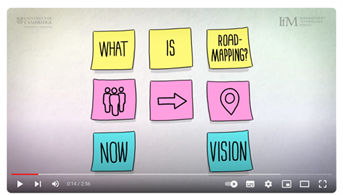
Source: https://www.youtube.com/@ifmcambridge
Step-by-step Development

1. Define the Objective
Purpose of the Roadmap: Before you dive into the specifics, understand the overarching goal. Are you developing a roadmap for customer-centric transformation as in this case, a product launch, or perhaps a digital transformation initiative? This objective will set the tone and direction for everything else.
2. Understand the Current State
Audit the Present: It is crucial to know where you stand before you chart out where you want to go. This involves assessing current processes, tools, systems, performance metrics, strengths, and weaknesses relevant to the roadmap’s purpose.
3. Engage Stakeholders
Gather Inputs: Different stakeholders bring unique perspectives. Engage teams or individuals who will be affected by the roadmap’s outcomes. This might include department heads, team leads, frontline staff, and even external stakeholders or customers.
4. Visualize Desired Outcome
End Goal: Create a vivid picture of what success looks like. Whether it’s achieving a specific business metric, introducing a set of features, or reaching a certain level of customer satisfaction, this vision will act as a compass for your roadmap.
5. Identify Key Milestones
Intermediate Steps: Breaking down the journey into key milestones makes the roadmap manageable and provides intermittent points of evaluation. These milestones can be based on timelines (quarterly, annually) or specific achievements (launching a monthly tracker of customer satisfaction and finalizing a set of KPIs).
6. Prioritize Initiatives
What Comes First: Not every action holds the same weight or urgency. Determine the priority of each initiative based on its potential impact, dependencies, required resources, and alignment with the overall objective.
7. Allocate Resources and Assign Responsibilities
Ownership and Accountability: Designate teams or individuals responsible for each initiative or milestone. Ensure they have the necessary resources, be it budget, tools, or personnel, to effectively carry out their tasks.
8. Set Timelines
Duration and Deadlines: Attach realistic timelines to each initiative and milestone. While it’s essential to be ambitious, it’s equally crucial to provide adequate time for thorough execution.
9. Feedback Mechanisms
Evaluation Points: Regularly review progress against the roadmap. This involves setting up performance metrics, KPIs, and feedback loops that allow for course corrections and adaptations as needed.
10. Communicate the Roadmap
Share and Collaborate: Once your roadmap is structured, ensure that it’s communicated to all relevant parties. This transparency supports collaboration, ensures alignment, and builds commitment across the organization.
11. Review and Update Regularly
Iterative Refinement: A roadmap is not set in stone. As external conditions change, new challenges emerge, or feedback is collected, revisit and adjust the roadmap to keep it relevant and actionable.
Starting with a clear objective and gradually diving into specifics while keeping stakeholders engaged ensures that the roadmap is not only strategic but also actionable and adaptive. Remember, a well-structured roadmap is a powerful tool, guiding an organization toward its goals with clarity and purpose.

Exercise 1.11a: “Development beginning”
Roadmap Development Challenges
Developing a roadmap is a valuable exercise, but it comes with its own set of challenges. Being aware of these challenges (which we now will go through) beforehand can help organizations navigate them more effectively.
Undefined Goals: Without clear, well-defined objectives, a roadmap can become ambiguous. The organization must know what it wants to achieve before plotting out the steps to get there.
Resistance to Change: Change, even if positive, often meets resistance. Cultural inertia, fear of the unknown, or concerns about added responsibilities can hinder roadmap development and implementation.
Resource Constraints: Developing a roadmap requires time, expertise, and often financial resources. Balancing these demands with other organizational priorities can be challenging.
Stakeholder Misalignment: Different stakeholders may have varying visions for the organization’s future. Ensuring everyone is aligned is crucial but can be difficult, especially in larger or more fragmented organizations.
Overambitious Planning: While ambition is commendable, it’s crucial that a roadmap remains realistic. Overloading it with too many initiatives or tight timelines can lead to burnout and decreased morale.
Underestimating Complexity: Some steps on the journey to customer-centricity (or any other goal) might be more intricate than initially assumed. Not accounting for this complexity can lead to delays and frustrations.
Inadequate Communication: A roadmap that’s not effectively communicated to all involved parties might lead to confusion, misaligned efforts, or missed milestones.
Lack of Flexibility: While a roadmap provides direction, it should not be so rigid that there’s no room for adjustments. A roadmap that doesn’t accommodate feedback or adapts to changing circumstances can become obsolete quickly.
Measuring Success: Determining the right metrics and KPIs for gauging progress can be challenging. Without proper measurement criteria, it’s hard to know if the organization is moving in the right direction.
Inconsistent Review: Failing to regularly review and update the roadmap can lead to stagnation. It’s essential to revisit it periodically to ensure it remains relevant and actionable.
Overlooking Dependencies: Some initiatives might depend on the successful completion of others. Not identifying and planning for these dependencies can lead to roadblocks.
Short-term Focus: While immediate gains are attractive, it’s essential that the roadmap also considers the long-term vision. Balancing short-term achievements with long-term objectives is a challenge.
By acknowledging these challenges upfront and proactively addressing them, organizations can increase the likelihood of developing a successful, impactful roadmap. It’s also beneficial to engage with experts or consult past case studies to learn from others’ experiences and best practices.

Exercise 1.11b: Flash Priorities

Course Manual 12: Organization Change
In this part of the workshop, we will look into how a customer-centric approach involves more than just customer service; it impacts every side of the business, from product design to marketing, sales, and after-sales support. As organizations strive to realign with this paradigm, change management becomes paramount, ensuring that the shift is seamless, sustainable, and effective.
Change Management Steps
Transitioning to a model that emphasizes customer-centricity begins with understanding and acknowledging the urgency to evolve from traditional practices. In this ever-competitive landscape, organizations must place the needs, preferences, and feedback of customers at the heart of their operations. The next phase involves gearing up for this significant shift. Organizations should construct a compelling narrative, highlighting the value and merits of adopting a customer-centric approach. This requires identifying key stakeholders and accurately crafting a strategic communication plan to ensure everyone, from top-tier executives to entry-level employees, is aligned with this vision.
As the foundation is laid, the focus should turn to strategizing the shift. The goal is to create a comprehensive plan that seamlessly integrates customer-centricity into every aspect of the organization. This extensive plan would not only address the tangible changes, such as refining product offerings based on feedback but also the intangible ones, like reimagining marketing narratives. It should also allocate necessary resources, establish clear timelines, and prepare for potential challenges that might arise.
With a clear roadmap in place, the organization can then embark on its transformative journey. This entails executing the devised strategies, which might involve rolling out new training programs, employing advanced tools for capturing customer feedback, and potentially restructuring teams to be more in tune with customer needs. It is crucial during this stage to continuously monitor the progress, ensuring that the organization remains agile and can swiftly address any emerging challenges.
However, implementing changes is just one part of the equation. The real challenge lies in ensuring that this customer-first ideology becomes an essential part of the organization’s identity. This means continuous training, robust mentorship programs, and consistently promoting and rewarding behaviors that prioritize customers.
The final, yet ongoing, phase of this transformation is monitoring and iterative refinement. Organizations should employ key metrics like customer satisfaction scores and retention rates to gauge the impact of their efforts. It is also essential to celebrate the milestones achieved, introspect on any setbacks, and remain committed to iterating based on real-time customer feedback.
In essence, the path to customer-centricity involves understanding, planning, executing, and refining. Through a systematic change management strategy, businesses can not only make this transition smoothly but also cultivate enduring, value-driven relationships with their customers.
Change Management Challenges

Leadership Alignment: The commitment and active involvement of senior leaders are paramount in change management. Their endorsement sets the tone for the entire organization. Without their support, even well-formulated plans can face undue challenges. Proactively involving leadership from the initiation phase and securing their dedication to the change initiative is essential for a successful transition.
Clear Communication: Effective communication serves as the backbone of any change management initiative. It is crucial to disseminate clear and consistent information regarding upcoming changes. Implementing a structured communication plan, which provides timely updates and incorporates mechanisms for feedback, ensures that misunderstandings are minimized and stakeholders are informed.
Handling Resistance: Resistance to change is a natural organizational phenomenon. The key to addressing this lies in proactive engagement. Initiating dialogues with employees, offering them relevant training, and highlighting the positive outcomes of the change can mitigate apprehensions and cultivate a more receptive environment.
Resource Allocation: The breadth and depth of change management efforts often necessitate a range of resources. This encompasses not only financial allocations but also the dedication of personnel time and effort. Properly assessing and then allocating these resources is vital to ensure the change initiative progresses without undue hindrances.
Thorough Planning: Detailed and strategic planning is the cornerstone of effective change management. Such a plan should comprehensively outline the steps to be taken, identify necessary resources, and highlight potential challenges, enabling the organization to anticipate and address hurdles in a timely manner.
Having the Right Expertise: Change management is a specialized domain, that demands specific skill sets and knowledge. Ensuring that your organization has access to this expertise is crucial. This might involve training existing personnel, hiring new specialists, or even collaborating with external consultants to bring the requisite knowledge on board.
Addressing Organizational Culture: Organizational culture can either be an accelerator for change or a barrier. In cases where the culture is inherently resistant to change, it is essential to adopt strategies that emphasize the benefits of the change, facilitate open communication, and provide robust training and support mechanisms.
In conclusion, change management, with its unique set of challenges, demands a multifaceted approach. By emphasizing early engagement, effective communication, meticulous planning, and ensuring the right expertise and support systems are in place, organizations can navigate the complexities of change effectively.

Exercise 1.12a: “Change Perspectives Role-Play”
Change Management Models

• Lewin’s Model: Involves three stages—unfreezing (preparing for change), changing (implementing the change), and refreezing (solidifying the change as the norm).
• McKinsey 7-S Model: Emphasizes alignment across seven organizational elements for successful change: strategy, structure, systems, shared values, style, staff, and skills.
• Kotter’s Theory: Consists of eight steps, from establishing urgency to anchoring new approaches within the organization’s culture.
• ADKAR Model: Centers on five elements essential for individuals to embrace change: awareness, desire, knowledge, ability, and reinforcement.
• Nudge Theory: Promotes the use of subtle strategies to motivate people towards desired behaviors.
• Kübler-Ross Curve: Describes the five emotional stages (akin to grief) individuals might undergo during change: denial, anger, bargaining, depression, and acceptance.
• Bridges’ Transition Model: Concentrates on managing the human experience during change, comprising ending, neutral zone, and new beginning stages.
• PDCA: An iterative process for continuous improvement, cycling through four stages: plan, do, check, and act.
In essence, while numerous change management models exist, the selection depends on the organization’s specific requirements and the nature of the anticipated change. Today we will have a closer look at two of these models, Lewin’s model, and Kotter’s Change Management Model.
Lewin’s Change Management Model and Kotter’s 8-Step Change Model are well-known frameworks that guide organizations through change. Distinguishing between them requires understanding their unique structures, focuses, and applications. Let us dissect these differences:
Lewin’s Change Management Model
• Developed by Kurt Lewin, a pshycologist, during 1940s
• Comprises three stages: unfreeze, change, and refreeze.
• Primarily targets managing the inherent uncertainties and resistance linked with change.
• Views change as a fluid process necessitating constant adaptation.
• Stresses the pivotal role of communication and fostering trust.
• Aimed at aiding leaders in comprehending and steering transitions.
Kotter’s 8-Step Change Model
• Introduced by Dr. John Kotter in his 1996 book, “Leading Change”
• Embodies a structured eight-step sequence starting from establishing urgency to anchoring new methodologies within the organization’s culture.
• Is tailored towards driving an entire organizational transformation.
• Perceives change as a defined, linear progression.
• Underlines the significance of strong leadership and articulating an impactful message.
• Designed to equip business managers in navigating organizational adjustments.
In a broader perspective, Lewin’s model centers on the complexities and dynamics of managing change, highlighting trust and communication. In contrast, Kotter’s approach is centered on catalyzing comprehensive organizational shifts, emphasizing the role of leadership and potent messaging. The selection between these models hinges on the specific organizational objectives and the nature of the change envisioned.
Model Selection

On the other hand, Kotter’s 8-Step Change Model is tailored more towards organizations that are large in scale and are at the stage of undergoing comprehensive transformations that resonate across the entirety of the organization. This model brings to the fore the need to articulate a potent and compelling message, aiming for an all-encompassing employee involvement in the change journey. Additionally, Kotter’s methodology shines in scenarios where there is an imperative to spark a sense of urgency. It advocates for the gathering of a dedicated group of change champions to steer the transition.
While both models offer their distinct advantages, the ultimate choice hinges on the specific dynamics and needs of the organization. It becomes paramount to thoroughly evaluate the organization’s structural details, its cultural pulse, and the envisioned goals before settling on a change management approach.
Case Study: Spotlight McDo
In the face of changing consumer demands and stiffening competition, McDonald’s found itself at a pivotal juncture in 2017. The fast-food giant felt the pressing need to revisit its foundational strategies and processes.
To initiate this transformation, McDonald’s tapped into Lewin’s change model, beginning with the ‘unfreeze’ phase. This entailed acknowledging and letting go of the traditional fast-food paradigm that had served them for decades. Leadership took the helm in explaining this shift, articulating the reasons behind the move, and painting a picture of how these changes could push the company forward, benefiting both the brand and its customers.
The transition phase saw the implementation of innovative strategies rooted in robust customer feedback and research. This included launching an all-day breakfast, providing greater menu customization, and accompanying in advanced in-store technologies to elevate efficiency and the overall customer experience. As is common with significant change, McDonald’s did face its share of resistance, especially from franchisees and some long-standing employees. Yet, through consistent communication, the provision of essential training resources, and collaborative engagement, the company ensured the smooth adoption of these changes across its network.
Post-implementation, the company went on an evaluative journey, making necessary tweaks based on outcomes. By embedding the newly adopted strategies into the company’s core policies and values, they ensured its longevity. Employees championing adaptability were acknowledged and incentivized, fostering a culture of continual evolution and evaluation.
Other Change Management Aspects

While top leadership endorsement is crucial, the role of middle management in change is often overlooked. They act as bridges between senior leaders and frontline employees, playing a key role in either facilitating or obstructing change, depending on their buy-in.
Open channels for feedback allow organizations to sense resistance, misunderstandings, or potential pitfalls early on. These feedback mechanisms, when taken seriously, not only pre-empt issues but also make employees feel valued and heard.
During extended periods of change, it is crucial to celebrate interim successes. Recognizing and celebrating small wins can bolster morale, maintain momentum, and offer proof that the effort is yielding results.
After the change is implemented, a retrospective analysis can provide valuable insights. What went well? What could have been done differently? This reflection can be a learning tool for future change initiatives.
In an era where change is constant, organizations should foster a culture of continuous learning and adaptability. This not only prepares them for change but also makes transitions smoother as adaptability becomes ingrained in the organizational culture.
Modern change management can be augmented with digital tools and platforms. From communication software that ensures everyone is aligned to analytical tools that track the progress of change, technology can be a significant enabler.
Organizations must ensure that change, especially when it involves restructuring or downsizing, is managed ethically. This includes transparent communication, offering support (like compensation packages or counseling), and ensuring that decisions are made with empathy.
Incorporating these aspects can enrich the understanding of change management, making it more holistic and effective. While models and methodologies offer structured paths, it is these nuances that often determine the success of change initiatives.

Exercise 1.12b: “Change reflection circle”

Project Studies
Project Study (Part 1) – Management
The Head of this Department is to provide a detailed report relating to the Championing Customer-Centricity process that has been implemented within their department, together with all key stakeholders, as a result of conducting this workshop, incorporating process: planning; development; implementation; management; and review. Your process should feature the following 12 parts:
01. Introducing Customer-Centricity
02. Collaborative Learning
03. Customer Feedback
04. Customer Segmentation
05. Persona Development
06. Customer Journey Mapping
07. Customer Experience (CX)
08. Customer-Centric Innovation
09. External Stakeholders
10. Internal Stakeholders
11. Roadmap Development
12. Organization Change
Please include the results of the initial evaluation and assessment.
Project Study (Part 2) – Marketing
The Head of this Department is to provide a detailed report relating to the Championing Customer-Centricity process that has been implemented within their department, together with all key stakeholders, as a result of conducting this workshop, incorporating process: planning; development; implementation; management; and review. Your process should feature the following 12 parts:
01. Introducing Customer-Centricity
02. Collaborative Learning
03. Customer Feedback
04. Customer Segmentation
05. Persona Development
06. Customer Journey Mapping
07. Customer Experience (CX)
08. Customer-Centric Innovation
09. External Stakeholders
10. Internal Stakeholders
11. Roadmap Development
12. Organization Change
Please include the results of the initial evaluation and assessment.
Project Study (Part 3) – Business Intelligence
The Head of this Department is to provide a detailed report relating to the Championing Customer-Centricity process that has been implemented within their department, together with all key stakeholders, as a result of conducting this workshop, incorporating process: planning; development; implementation; management; and review. Your process should feature the following 12 parts:
01. Introducing Customer-Centricity
02. Collaborative Learning
03. Customer Feedback
04. Customer Segmentation
05. Persona Development
06. Customer Journey Mapping
07. Customer Experience (CX)
08. Customer-Centric Innovation
09. External Stakeholders
10. Internal Stakeholders
11. Roadmap Development
12. Organization Change
Please include the results of the initial evaluation and assessment.
Project Study (Part 4) – R&D (Product Development)
The Head of this Department is to provide a detailed report relating to the Championing Customer-Centricity process that has been implemented within their department, together with all key stakeholders, as a result of conducting this workshop, incorporating process: planning; development; implementation; management; and review. Your process should feature the following 12 parts:
01. Introducing Customer-Centricity
02. Collaborative Learning
03. Customer Feedback
04. Customer Segmentation
05. Persona Development
06. Customer Journey Mapping
07. Customer Experience (CX)
08. Customer-Centric Innovation
09. External Stakeholders
10. Internal Stakeholders
11. Roadmap Development
12. Organization Change
Please include the results of the initial evaluation and assessment.
Project Study (Part 5) – Commercial Excellence
The Head of this Department is to provide a detailed report relating to the Championing Customer-Centricity process that has been implemented within their department, together with all key stakeholders, as a result of conducting this workshop, incorporating process: planning; development; implementation; management; and review. Your process should feature the following 12 parts:
01. Introducing Customer-Centricity
02. Collaborative Learning
03. Customer Feedback
04. Customer Segmentation
05. Persona Development
06. Customer Journey Mapping
07. Customer Experience (CX)
08. Customer-Centric Innovation
09. External Stakeholders
10. Internal Stakeholders
11. Roadmap Development
12. Organization Change
Please include the results of the initial evaluation and assessment.
Project Study (Part 6) – Business Development
The Head of this Department is to provide a detailed report relating to the Championing Customer-Centricity process that has been implemented within their department, together with all key stakeholders, as a result of conducting this workshop, incorporating process: planning; development; implementation; management; and review. Your process should feature the following 12 parts:
01. Introducing Customer-Centricity
02. Collaborative Learning
03. Customer Feedback
04. Customer Segmentation
05. Persona Development
06. Customer Journey Mapping
07. Customer Experience (CX)
08. Customer-Centric Innovation
09. External Stakeholders
10. Internal Stakeholders
11. Roadmap Development
12. Organization Change
Please include the results of the initial evaluation and assessment.
Project Study (Part 7) – UX & Design
The Head of this Department is to provide a detailed report relating to the Championing Customer-Centricity process that has been implemented within their department, together with all key stakeholders, as a result of conducting this workshop, incorporating process: planning; development; implementation; management; and review. Your process should feature the following 12 parts:
01. Introducing Customer-Centricity
02. Collaborative Learning
03. Customer Feedback
04. Customer Segmentation
05. Persona Development
06. Customer Journey Mapping
07. Customer Experience (CX)
08. Customer-Centric Innovation
09. External Stakeholders
10. Internal Stakeholders
11. Roadmap Development
12. Organization Change
Please include the results of the initial evaluation and assessment.
Project Study (Part 8) – Communications
The Head of this Department is to provide a detailed report relating to the Championing Customer-Centricity process that has been implemented within their department, together with all key stakeholders, as a result of conducting this workshop, incorporating process: planning; development; implementation; management; and review. Your process should feature the following 12 parts:
01. Introducing Customer-Centricity
02. Collaborative Learning
03. Customer Feedback
04. Customer Segmentation
05. Persona Development
06. Customer Journey Mapping
07. Customer Experience (CX)
08. Customer-Centric Innovation
09. External Stakeholders
10. Internal Stakeholders
11. Roadmap Development
12. Organization Change
Please include the results of the initial evaluation and assessment.

Project Study (Part 9) – E-business
The Head of this Department is to provide a detailed report relating to the Championing Customer-Centricity process that has been implemented within their department, together with all key stakeholders, as a result of conducting this workshop, incorporating process: planning; development; implementation; management; and review. Your process should feature the following 12 parts:
01. Introducing Customer-Centricity
02. Collaborative Learning
03. Customer Feedback
04. Customer Segmentation
05. Persona Development
06. Customer Journey Mapping
07. Customer Experience (CX)
08. Customer-Centric Innovation
09. External Stakeholders
10. Internal Stakeholders
11. Roadmap Development
12. Organization Change
Please include the results of the initial evaluation and assessment.

Project Study (Part 10) – Legal
The Head of this Department is to provide a detailed report relating to the Championing Customer-Centricity process that has been implemented within their department, together with all key stakeholders, as a result of conducting this workshop, incorporating process: planning; development; implementation; management; and review. Your process should feature the following 12 parts:
01. Introducing Customer-Centricity
02. Collaborative Learning
03. Customer Feedback
04. Customer Segmentation
05. Persona Development
06. Customer Journey Mapping
07. Customer Experience (CX)
08. Customer-Centric Innovation
09. External Stakeholders
10. Internal Stakeholders
11. Roadmap Development
12. Organization Change
Please include the results of the initial evaluation and assessment.

Project Study (Part 11) – Logistics
The Head of this Department is to provide a detailed report relating to the Championing Customer-Centricity process that has been implemented within their department, together with all key stakeholders, as a result of conducting this workshop, incorporating process: planning; development; implementation; management; and review. Your process should feature the following 12 parts:
01. Introducing Customer-Centricity
02. Collaborative Learning
03. Customer Feedback
04. Customer Segmentation
05. Persona Development
06. Customer Journey Mapping
07. Customer Experience (CX)
08. Customer-Centric Innovation
09. External Stakeholders
10. Internal Stakeholders
11. Roadmap Development
12. Organization Change
Please include the results of the initial evaluation and assessment.

Project Study (Part 12) – Education
The Head of this Department is to provide a detailed report relating to the Championing Customer-Centricity process that has been implemented within their department, together with all key stakeholders, as a result of conducting this workshop, incorporating process: planning; development; implementation; management; and review. Your process should feature the following 12 parts:
01. Introducing Customer-Centricity
02. Collaborative Learning
03. Customer Feedback
04. Customer Segmentation
05. Persona Development
06. Customer Journey Mapping
07. Customer Experience (CX)
08. Customer-Centric Innovation
09. External Stakeholders
10. Internal Stakeholders
11. Roadmap Development
12. Organization Change
Please include the results of the initial evaluation and assessment.
Program Benefits
Management
- Transparency
- Capability building
- Stronger growth
- Easier decision-making
- Relevant investments
- Increased profitability
- Enhanced reputation
- Reduced costs
- Greater efficiency
- Innovative solutions
Strategy
- Efficient goal-setting
- Effective strategies
- Easier decision-making
- Resource optimisation
- Effective price-setting
- Accurate forecasts
- Sharpened targeting
- Effective collaboration
- Improved buy-in
- Better planning
Marketing
- Competitive advantage
- Greater awareness
- Increased share
- Stronger brand
- Brand loyalty
- Increased revenue
- Improved communication
- Efficient campaigns
- Customer satisfaction
- Customer retention
Client Telephone Conference (CTC)
If you have any questions or if you would like to arrange a Client Telephone Conference (CTC) to discuss this particular Unique Consulting Service Proposition (UCSP) in more detail, please CLICK HERE.















































